The Tribune
McGill must protect its queer students and stand against growing bigotry
Home runs in a circular motion
PG. 8-9
Revisiting Lucy Maud Montgomery
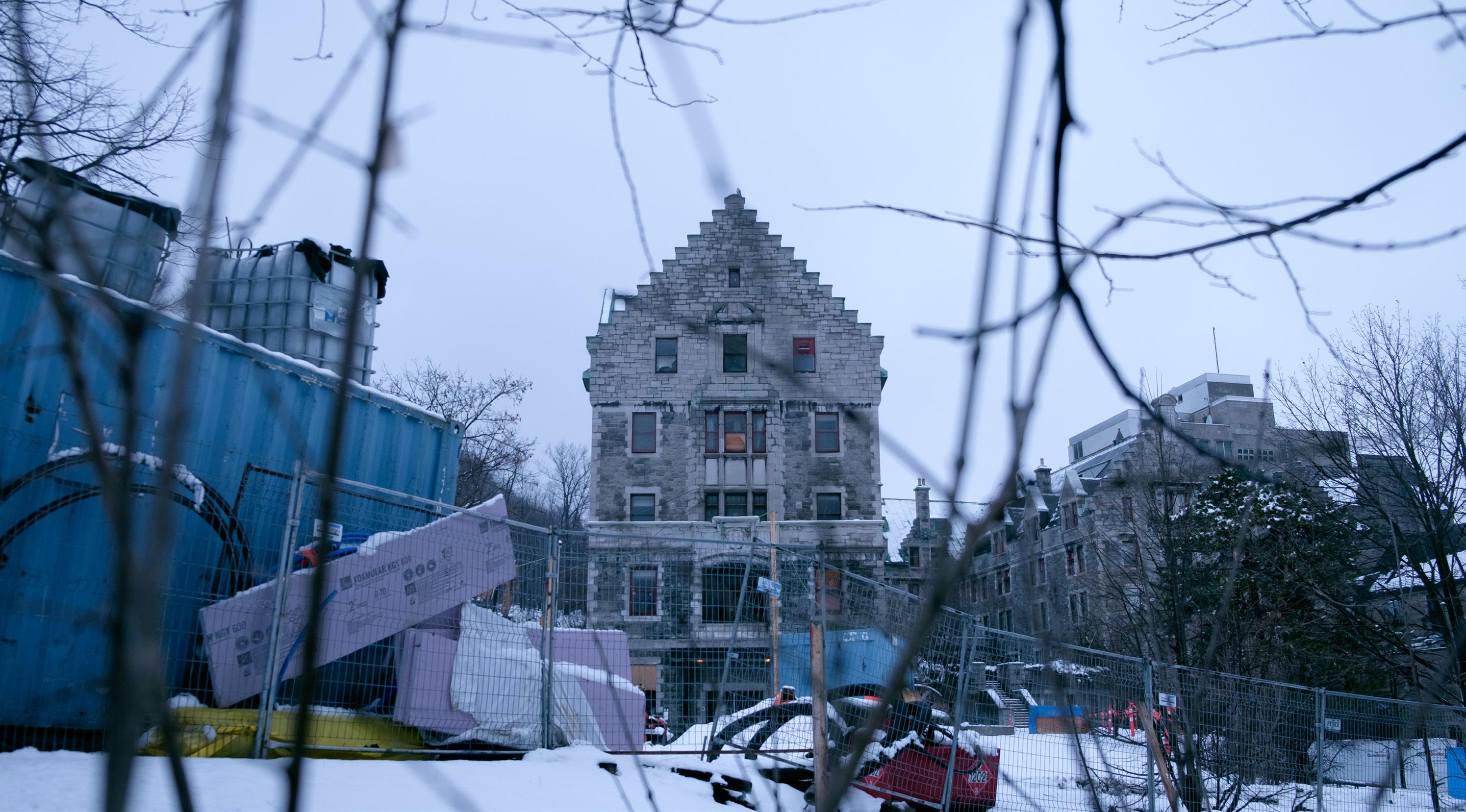
From hypermasculinity to policy advisor: McGill’s alarming choice for Indigenous oversight PG. 16
Tribute: Remembering Professor Monica Popescu
Friends, colleagues, and students reflect on the intellectual’s legacy
Matthew Molinaro Editor-in-Chief
Born in Brasov, Romania in 1973, Monica Popescu was a star student throughout her studies. After receiving degrees from the University of Bucharest, the University of Windsor, and the University of Pennsylvania, she began teaching at McGill in 2005, where she taught courses on African literatures,
literary and social theory, imperialism, gender studies, and the Cold War. On February 24, after a year-long battle with glioblastoma, Monica passed away at age 50.
In her presence, we were all Monica’s students. Her commitment to anticolonial pedagogy challenged what this university and a liberal arts education could be—she always “moved the centre” to use Ngũgĩ’s phrase. In teaching the mandatory survey course for English literature majors, she passionately lectured about Af-
Behind closed doors: How family physicians struggle against social inequities
Investigating the effects of proximity and moral distress in healthcare
Jenna Durante Contributor
At their best, family physicians in Canada stand as critical frontline defenders for vulnerable patient pop-
ulations. In a recent study titled, “You are the only other person in the world that knows that about me: Family physician stories of proximity to patients experiencing social inequity,” 20 Ontario-based
family physicians shared their experiences and relationships with patients who were struggling with issues such as inadequate housing, lack of education, low income, and substance abuse. PG.12
Queer McGill
rican, Caribbean, and South Asian histories, literary traditions, and revolutionary struggles. Over many eagerly anticipated office hour visits, her encyclopedic knowledge, fierce determination, and tender soul enchanted me, as did our discussions on Zoe Wicomb, post-Communist politics, and campus organizing. I was lucky to have Monica as my Honours supervisor and to grow under her exuberant light, warmth, and mentorship. Her words, lessons, and generosity fortify me—I will miss her dearly.
PG.
Deadnaming Dashboard
highlights deadnaming and misgendering in McGill IT systems
Queer McGill continues decade-long effort to remove instances of automated deadnaming and misgendering.
Esther Forbes Contributor
Queer McGill—a service run by queer students for queer students, non-students in the Montreal area, and allies—
started a Deadnaming Dashboard “to end automated deadnaming and misgendering [...] last fall,” within IT systems such as Minerva, MyCourses, UPrint, and the Student Wellness Hub (SWH).
The Dashboard displays
all McGill IT services that are currently misgendering and deadnaming students, as well as status updates regarding specific ways in which these online services are failing trans students—all of which currently read “not fixed.”
THETRIBUNE.CA | @THETRIBUNECA
by the SPT, a student society of McGill University FEATURE
Published
EDITORIAL
ARTS
ENTERTAINMENT
&
PG. 5 PG. 7
VOL.
TUESDAY, MARCH 12 2024 |
43 | ISSUE 21
14
PG.3
Mason Bramadat / The Tribune
Open letter supporting Hunger Strike for Palestine amasses over 1,000 signatures
Calls mount for McGill to cut ties with corporations and institutions complicit in Israel’s genocide of Palestinians
Fabienne de Cartier Staff Writer
On Mar. 2, a group of McGill alumni drafted an open letter to McGill’s administration in support of the McGill Hunger Strike for Palestine. As of March 10, , it has received over 1,100 signatures from alumni, faculty, and students alike. The letter calls on McGill to meet the demands of the hunger strikers by cutting ties with corporations and academic institutions complicit in Israel’s ongoing siege on Gaza and the genocide of Palestinians.
The hunger strike was launched by twelve students on campus. Sage*, U3 Arts and member of McGill Hunger Strike for Palestine, told The Tribune that the strike came after the university ignored students’ continued demand that McGill take a stand against the genocide in Palestine.
“We have been protesting, emailing, and calling the Board [of Governors], and we just haven’t had any response back,” Sage said. “So for us, this was really our last chance to show them that we were actually very serious about this.”
The open letter, which started circulating eighteen days into the strike, urges McGill to meet the demands of the hunger
strikers and divest from companies directly or indirectly supporting Israel’s genocide against Palestinians. Solidarity for Palestinian Human Rights (SPHR) estimates that these investments total approximately $20 million—including $519,949 in Lockheed Martin, $1,546,209 in Safran SA, $1,820,816 in Airbus SE, $1,217,646 in L’Oréal, $1,323,824 in Thales SA, $1,396,445 in Chevron Corp, $1,215,308 in Coca-Cola, $11,372,580 in Royal bank of Canada, and $605,482 in Unilever
The letter also supports hunger strikers’ demand that McGill boycott academic institutions complicit in the genocide of Palestinians, including universities involved in Israel’s military research and development. Although the university has stated that they will not cut ties with academic institutions because of where they are located, the letter asserts that the boycott demands were not linked to the institutions’ location but rather stemmed from their involvement in the human rights abuses against Palestinians.
The letter reads, “We wish to emphasize that the calls to cut ties with Israeli academic institutions are not aimed at institutions because of where they are located. Rather, they are aimed at specific Israeli institutions with well-documented records of complicity in
human rights violations against Palestinians.”
The authors of the letter also condemn McGill’s response to the hunger strike. Sage explained that although the McGill administration has been willing to meet with the hunger strikers, they have been unable to agree on the terms of a meeting. On Feb. 19, McGill invited the hunger strikers to meet with them. On Feb. 21, the hunger strikers responded, asking for a public meeting so that students supporting the cause could attend and asked McGill to set the meeting a week in advance so that hunger strikers could sufficiently prepare. They also asked to meet for at least an hour and a half so they would have enough time to discuss their demands.
According to the group, on Feb. 28, the McGill administration agreed to these terms and set a meeting date for Mar. 11. However, they quickly rescinded the offer. Later that day, the McGill administration stated that although they would be willing to explore a public meeting in the future, they wished to have a private meeting with the strikers on Mar. 4, given the health risks of a hunger strike and the urgency of the situation. Strikers refused the terms of this meeting, maintaining that they were uninterested in discussing the health of the strikers. In re-
sponse, McGill stated that they felt a meeting to discuss the hunger strikers’ demands would be unproductive. Consequently, discussions stalled and students continued their strike over the reading break.
“McGill supports the rights of students to exercise their rights in connection with civic engagement in accordance with the Charter of Student Rights and applicable laws [.…] It is equally important to note that all members of our community have the right to learn, teach and work in a peaceful environment. Any civic engagement that results in a hindrance of those rights is not acceptable,” McGill’s media relations officer Frédérique Mazerolle wrote to The Tribune
Although the hunger strike does not interfere with the conduction of classes, SPHR, asserted that “[the hunger strikers] demonstrate how McGill’s inaction and refusal to heed student demands has pushed committed students to extreme forms of protest.”
Sage told The Tribune they were hopeful the letter would pressure the university to take the demands of the hunger strikers seriously.
“[The letter] legitimizes our strike,” Sage said. “We believe that support from alumni, staff, and faculty is a good step forward.”
AGSEM plans to hold strike vote during week of March 11
McGill filed for conciliation on Feb. 26
Caroline Sun News Editor
After months of bargaining meetings with McGill to negotiate a new Collective Agreement (CA), the Association of Graduate Students Employed at McGill (AGSEM) is holding a strike vote during the week of Mar. 11. This decision comes after teaching assistants (TAs) gathered at an assembly on Jan. 30, during which members voted unanimously on a motion mandating AGSEM’s Mobilization, TA bargaining, and Executive Committees to organize an assembly and hold a vote for a strike mandate. If the vote passes, all teaching assistants (TAs) currently working at McGill will go on strike.
The union submitted its monetary proposal on Dec. 18, 2023, demanding a wage raise from $33.03 per hour to $46.36 per hour—which AGSEM claims is the average amount TAs make at other Canadian universities, such as the University of Toronto. It also seeks a cost-of-living adjustment, meaning that wages will follow a change in inflation if the latter is more than three per cent. Furthermore, the group wants the university to adjust TAs’ working hours to the number of students in the class that they are TAing. Lastly, AGSEM is asking that McGill provide healthcare benefits for TAs and that care be divided into three types: Care for domestic students, care for international students, and gender-affirming care.
According to AGSEM, McGill submitted its monetary proposal on Feb. 2, proposing a 1.25 per cent wage raise—which equates to an increase of 41 cents per hour—with a 1 per cent increase for each subsequent year. This stood in stark contrast
to the 40 per cent AGSEM demanded. McGill’s proposal did not include sections concerning indexing working hours to class sizes, cost-of-living adjustments, or healthcare.
Following their first monetary proposal, McGill proposed a 2.25 per cent wage increase on Feb. 26, raising the hourly rate to $33.77 with a 1.25 per cent increase for each following year. AGSEM wrote in its newsletter that this increase does not address inflation, which totalled 4.45 in 2023 in Quebec.
In their newsletter, AGSEM wrote that McGill framed its offer in the context of the decreasing funding from the Quebec government. History Delegate to the union, member of the bargaining support committee, and TA Donnie Morard acknowledged McGill’s tight financial situation but noted that expenses related to TAs—around 13 million per year according to AGSEM’s estimates—amount to a very small portion of the institution’s operating budget.
“I believe our wages amount to something close to [one] per cent, likely less, of McGill’s budget,” Morard said. “This is despite the invaluable work we do running labs, teaching conferences, and grading assignments. Giving TAs a big raise is a good investment in improving the quality of education at the university, especially since it won’t seriously undermine McGill’s bottom line.”
As the union did not accept McGill’s proposals, the university filed for conciliation. According to Harlan Hutt, president of the Association of McGill University Support Employees, conciliation consists of the process where “the union and employer bring in an independent arbitrator to help negotiate a collective agreement when they reach
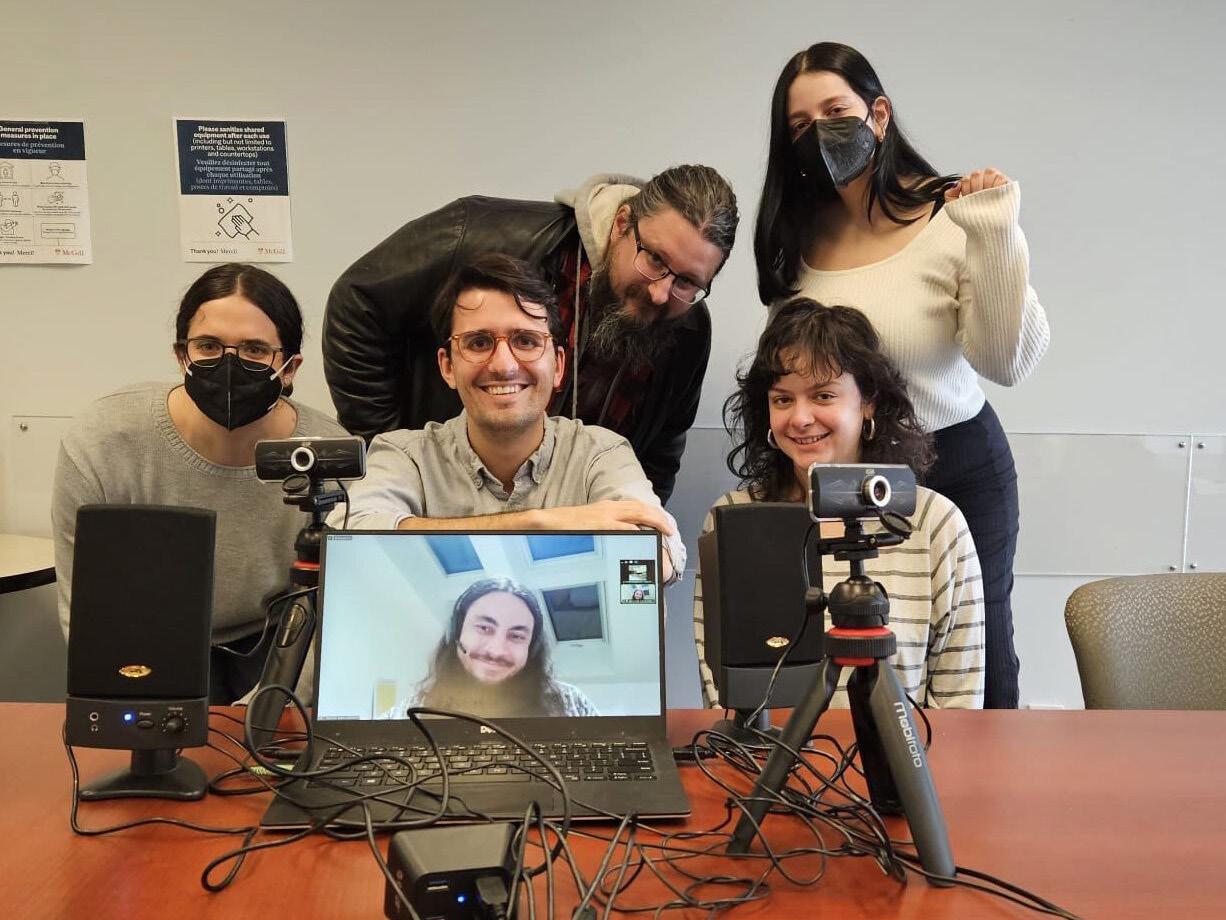
an impasse in collective bargaining.”
“Conciliation is normal within the process of negotiating a Collective Agreement, and is a standard part of collective bargaining. AMUSE has utilized conciliation before, notably during our 2017 Collective Agreement negotiation with McGill.”
AGSEM will hold two of its assemblies for the strike vote at Centre Mont-Royal, near the downtown campus, one on Wednesday, Mar. 13 at 6 p.m. and the other on Saturday, Mar. 16 at 2 p.m. It will also organize a meeting at 2 p.m. on Mar. 14 at McGill’s MacDonald Campus. Members only need to go to one of the assemblies to vote.
Negotiations will continue in the meantime, as both parties are planning to meet on Mar. 14, a day after assemblies for the strike vote start. Fanny Teissandier, a TA and AGSEM Anthropology Delegate, stated that the union seeks to avoid a strike in an email to The Tribune
“The AGSEM bargaining team has told McGill and the conciliators that the union is willing to negotiate every single day ahead of our strike vote assemblies,” Teissandier stated. “On March 14 and 19, McGill may still avert a strike by reaching a tentative agreement with AGSEM’s bargaining team, which will be presented to the union’s membership for ratification.”
McGill declined to comment for this piece.
news@thetribune.ca TUESDAY, MARCH 12 2024 2 NEWS
AGSEM and McGill also went through conciliation before establishing the union’s and employer’s last collective agreement, which was signed on Jan. 14, 2021. (AGSEM)
Writer and filmmaker asinnajaq explores art, technology, and perspective in virtual talk
Disrupting Disruptions and Indigenous Futures Research Centre co-organize event
Eliza Lee News Editor
On Feb. 29, artist, writer, curator, and filmmaker asinnajaq took to Zoom to give a talk on their artistic practice and works. The talk was organized as part of the Disrupting Disruptions: Feminist and Accessible Publishing, Communications, and Technologies speaker and workshop series in collaboration with the Indigenous Futures Research Centre (IFRC) at Concordia University, an organization that supports Indigenous-led research.
Disrupting Disruptors is a series that unites diverse disciplines such as computer science, feminist studies, LGBTQIA+ studies, and critical race theory to explore “critical approaches to
publishing practices, innovative communication strategies, and techniques for making research dissemination more accessible.” The Institute for Gender, Sexuality and Feminist Studies (IGSF) at McGill also provides financial and administrative support for the series.
Remarking that “making slideshows is one of [their] love languages,” asinnajaq began their presentation by discussing some of the methods and core values that they bring to their work. They noted the importance of asking themself “Am I the person to do this?” when approaching a project and reflecting on how they can bring their unique perspective to the art, as well as doing research and listening to others to best explore the subject at hand.


asinnajaq then described several of their mixed media artistic projects, such as the installation Where you go I follow, which incorporates a photograph printed on a fabric sheet and written scores. They also detailed their installations Nuna and qulliq as part of the exhibit / Ruovttu Guvlui / Towards Home, which originally appeared in the Canadian Centre For Architecture. asinnajaq’s work in the exhibit included creating an augmented reality (AR) artwork as part of Geronimo
Inutiq’s installation, which audiences could view using Microsoft Hololens. The AR exhibit depicted an ever-changing landscape in the gallery room—clouds hanging overhead, a running river, and iridescent ravens swooping from perch to perch.
“[This] installation to me was really about Iqaluit and about the feeling of being there,” asinnajaq said. “One thing that I could see that I could really add to make it feel like Iqaluit was to add something about the atmosphere and some environmental elements like the clouds, the water. And [...] we have the Raven which are iconic for their tenacity [...] and their character.”
asinnajaq finished their presentation by discussing their 2017 documentary short film, Three Thousand, which they created out of archives from the National Film Board of Canada. They explained that the film uses roughly 100 years of archival representations of the Inuit to create a “timeline of colonization and our cultural fabric.”
During the question and answer period, asinnajaq spoke to the way the film is for them “a document primarily for Inuit so that we can see and understand how we got to where we are,” while also underscoring the possibilities for change.
“Because there are some people, some fellow Inuit that I know, that sometimes forget [...] the situation we’re in with really precarious situations with mental health, housing, food, safety, security [...] and trauma that so many people are moving through is not an inherent part of us, and it’s happening for a reason,” asinnajaq said.
“While doing that, I always want to leave space for hope [...] that we can create worlds that we want [....] This world is a created world, and we can create worlds.”
Alex Ketchum—the organizer of Disrupting Disruptions and Assistant Professor at the IGSF—spoke to the connections between asinnajaq’s work and the themes of the series in an email to The Tribune
“The asinnajaq event came about due to my partnership with the Indigenous Futures Research Centre,” Ketchum wrote, noting that their “work thoughtfully engages with technology.”
IFRC programming coordinator Joëlle Dubé explained in an email to The Tribune that the organization’s collaboration with Disrupting Disruptions for the speaker series was motivated by an interest in exploring disciplines in science, technology, engineering, art, and math (STEAM), as well as from Indigenous, queer, and feminist perspectives.
“Whereas the acronym used to be STEM, we were curious to delve deeper into the role arts can play as the latest inclusion within this cluster of disciplines,” Dubé wrote. “We thought that the way asinnajaq makes use of new technology, through their work as a filmmaker, an artist, and a curator exemplifies a not-yet-presented perspective or facet of STEAM, one that pertains to visual storytelling.”
The next event in the Disrupting Disruptions Series is a workshop by Gabryelle Iaconetti and Liam Devitt on Queer Oral Histories on Mar. 15.
Queer McGill Deadnaming Dashboard highlights deadnaming and misgendering in McGill IT systems
Queer McGill continues decade-long effort to remove instances of automated deadnaming and misgendering.
Esther Forbes Contributor
Continued from page 1.
Queer McGill invites students dealing with these issues to contact them for support when being misgendered by McGill IT systems.
The group explained that the university has long deadnamed and misgendered trans students, though McGill claims to have made progress.
“Trans students continue to be dead-named and misgendered by automated IT systems from attendance sheets to departmental mailing lists. McGill’s Wellness Hub and housing department are aware of these problems but resist calls for change [....] These systems give staff unnecessary access to trans students’ deadnames, and some—like the Student Wellness Hub—have no documented process to make a change at all,” Queer McGill wrote to The Tribune
In an email to The Tribune, McGill Media Relations Officer Frédérique Mazerolle reaffirmed McGill’s “efforts to challenge transphobia, biphobia, and homophobia and to foster a robust sense of belonging for all within our campus community, regardless of gender or sexual identity.” Mazerolle also noted that the Deputy Provost of Student Life and Learning Fabrice Labeau launched an Ad Hoc Committee on Preferred Names in February 2024, to address IT-specific deadnaming and misgendering issues.
“The goal of this committee is to investigate current areas where McGill IT systems are fall-
ing short compared to those outlined in the 2021 SSMU Report Preferred Name and Pronoun Use at McGill University, and track progress. Committee members include representatives from Enrolment Services, Student Services, IT Services, the Equity Office, Human Resources, and the SSMU,” Mazerolle wrote.
A McGill student who wished to be unnamed said that their efforts to have deadnaming issues fixed by McGill staff have gone unaddressed, leading to anxiety and apprehension about what inclass deadnaming could lead to.
“Honestly, it’s devastating. I’ve spoken to multiple people, multiple times to sort out this issue and nothing has ever changed [....] One of my professors has offered to contact people on my behalf within McGill about this issue and has received no response. Each time it’s the first week of classes I’m terrified that my legal name will be called out instead of my preferred name. I also have to see my legal name every time I use teams, which is daily,” they said.
Queer McGill Resource Coordinator Arwyn Regimbald also spoke to McGill residence staff, who continuously misgendered them whilst they were living in residence, describing this as “pervasive attacks on [their] dignity, self-worth, and ability to function.”
“When I lived in student residence, the staff systematically deadnamed and misgendered me in nearly every interaction I had,” Regimbald said. “I repeatedly cautioned them; I asked them to stop; I involved McGill admin. There was one time where they started crossing off my (then) preferred

name on parcels, and writing my deadname. One residence worker even told me I was committing a criminal offence by using a name that wasn’t legally mine.”
Queer McGill Administrative Coordinator Abe Berglas reported that McGill departmental heads often refuse to believe students when they report deadnaming, leading to students being unwillingly outed.
“When we come up with proof, they explain why the system works the way it does. But knowing that the transphobia is impersonal doesn’t pro-
tect us from being outed. I’ve never seen a group of people more defensive about being able to continue their transphobia. When potential new students ask me if McGill is accepting to queer students, I can’t say yes in good conscience,” Berglas said.
Despite ongoing efforts made by Queer McGill, they wrote that “trans students continue to be dead-named and misgendered by automated IT systems from attendance sheets to departmental mailing lists,” and although “McGill’s Wellness Hub and housing department are aware of these problems, [they] resist calls for change.”
The talk was the 94th event in the Disrupting Disruptions series, which is now in its sixth season. (Mason Bramadat / The Tribune)
news@thetribune.ca 3 NEWS TUESDAY, MARCH 12 2024
A call to action by the SSMU to resolve deadnaming and misgendering at McGill made in 2021 remains unfulfilled. (Mason Bramadat /The Tribune)
Lily Cason Managing Editor
TTribune Explains: Tenants’ rights in Montreal Bill 31 effectively ends lease transfers
he apartment search is ramping up for many as Quebec’s July 1 moving date looms closer. The Tribune brings you a guide to understanding and invoking your rights as a tenant when renting an apartment.
What are the regulations around landlords increasing rent?
Landlords must give written notice of their intention to increase rent three to six months before the end of the lease. If they do not meet this deadline, the rent must stay the same the following year.
Each year, the Tribunal administratif du logement (TAL) recommends a percentage by which landlords adjust rent, but does not set a hard cap on rent increases. The Tribunal suggests tenants negotiate with their landlord if they think the rent increase is too steep and allows tenants to formally contest increases with the TAL if negotiation does not work.
What other housing regulations exist?
• Landlords cannot require a security deposit. They can, however, request the first month’s rent early when the tenant signs the lease.
• Landlords must give 24 hours notice before entering a tenant’s apartment, except in the case of an emergency. Visits should be between 9 a.m. and 9 p.m., and work should be done between 7 a.m. and 7 p.m.
• Landlords must respond to unsanitary conditions—for example, a pest infestation or seri-
ous plumbing problem. If a landlord does not intervene promptly, the tenant can call 311 to have the city intervene to ensure decent living conditions.
• Landlords must perform urgent repairs—for example, fixing a broken front door that will not lock. If a tenant cannot get in touch with their landlord over an urgent matter, they are allowed to take reasonable action and demand reimbursement from the landlord.
• If a landlord wishes to repossess an apartment that has a lease of over six months, they must give notice at least six months before the lease ends. In the case of a six-month lease, they must give notice at least one month before the lease ends.
• Tenants are able to break their lease if they are no longer able to live in the dwelling due to a disability, if they or their child is the victim of domestic abuse, or if they have been allocated low-rent housing.
What is Bill 31?
On Feb. 21, Quebec’s Bill 31, “an Act to amend various legislative provisions with respect to housing,” came into effect. Among other provisions, the Bill means that lease transfers—the ability to sign over one’s lease to another person, protecting the rent from hikes—can now be stopped by landlords without reason. Previously, landlords had to have “serious concerns” to deny a transfer. The Coalition of Housing Committees and Tenants Associations of Quebec and other organizations that advocate for tenants have protested the Bill, saying
that limiting lease transfers will dramatically worsen the already critical housing crisis in Montreal. In 2023, the CBC reported that Quebec’s unhoused population had nearly doubled in four years.
Where can one get legal information and advice on housing law?
The Legal Information Clinic at McGill (LICM) and the StudentCare legal care program are both valuable resources for students who believe their housing rights have been violated. The LICM is staffed by McGill law students and provides legal information and know-your-rights workshops for students and the Montreal community. The StudentCare legal care program is available to students through the Students’ Society of McGill University (SSMU) insurance plan for an opt-outable $30 per year. The program allows students to access both legal advice and legal representation.
The TAL can be reached by phone or email. Appointments at the Tribunal’s information offices can be booked online.
How does one file a complaint if their rights are being abused?
It is a good idea to make it clear to your landlord that you know your rights. If they still do not take corrective action to respect your rights, you can take the
issue to the TAL—a process the LICM, the StudentCare legal care program, or the TAL themselves are equipped to help you navigate. An application can be filed online, in person, or by mail.

According to Centraide Montreal, 1 in 5 households is not able to afford to pay for both rent and other basic needs.
(Mason Bramadat / The
Tribune)
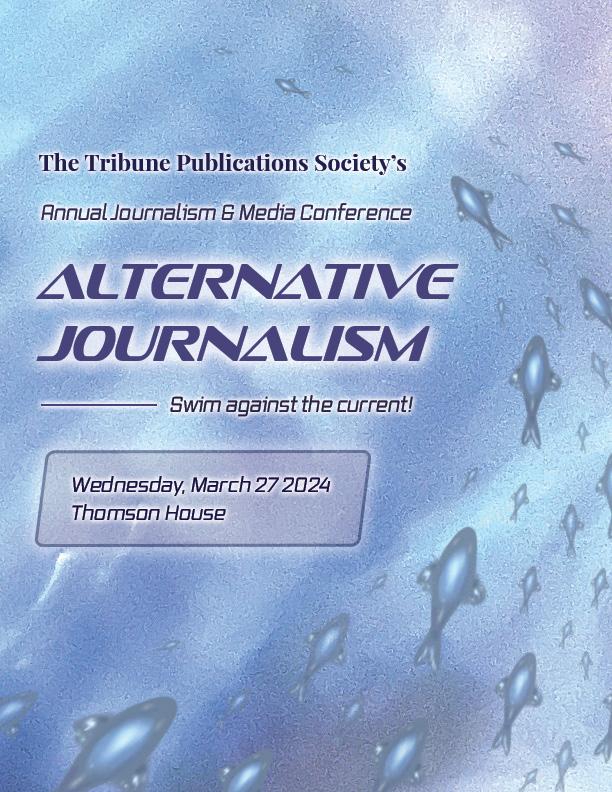
news@thetribune.ca 4 NEWS TUESDAY, MARCH 12 2024
Editor-in-Chief Matthew Molinaro editor@thetribune.ca
Creative Director Mika Drygas mdrygas@thetribune.ca
Managing Editors
Lily Cason lcason@thetribune.ca
Arian Kamel akamel@thetribune.ca
Tillie Burlock tburlock@thetribune.ca
News Editors Eliza Lee, Jasjot Grewal, & Caroline Sun news@thetribune.ca
Opinion Editors
Chloé Kichenane, Liliana Mason, & Isaiah Albert-Stein opinion@thetribune.ca
Science & Technology Editors Ella Paulin & Coco Zhang scitech@thetribune.ca
Student Life Editors Abby McCormick & Dante Ventulieri studentlife@thetribune.ca
Features Editor Fanta Ly features@thetribune.ca
Arts & Entertainment Editors
Dana Prather & Suzanna Graham arts@thetribune.ca
Sports Editors
Sara Escallon-Sotomayor & Julie Ferreyra sports@thetribune.ca
Design Editors Drea Garcia & Zoe Dubin design@thetribune.ca
Photo Editor Mason Bramadat photo@thetribune.ca
Multimedia Editor Anna Chudakov & Alyssa Razavi Mastali multimedia@thetribune.ca
Web Developers
Eleni Lyberopoulos & William Kiem Lafond webdev@thetribune.ca
Copy Editor Theodore Yohalem Shouse copy@thetribune.ca
Social Media Editor Sainka Walia socialmedia@thetribune.ca
Business Manager Sophie Smith business@thetribune.ca
McGill must protect its queer students and stand against growing bigotry
The Tribune Editorial Board
On Feb. 22, 2024, the town of Westlock, Alberta, voted to prohibit rainbow crosswalks and flying anything other than government flags. This measure is yet another recent example of Canadian politicians implementing homophobic and transphobic policies, all of which normalize hatred against queer communities.
The Westlock decision came after Alberta Premier Danielle Smith announced a dangerous plan early last month to prevent young people from accessing genderrelated therapies such as hormones and puberty blockers. In response to Smith’s policy, Conservative leader Pierre Poilievre claimed that young people should only be able to make choices concerning their bodies “when they’re adults” and explicitly stated his opposition to puberty blockers for people under 18. Poilievre also affirmed his undying support for trans-exclusionary rhetoric, saying that trans women have no place in women’s sports.
As politicians weaponize women’s identities and openly disregard science to serve their electoral agenda, institutions—from all levels of government to universities—must
OFF THE BOARD
Julie Ferreyra Sports Editor
Zeppelli, Abby Zhu

Every year, as winter festivities approach, an air of excitement comes around that fills most with joy. For others, however, the holiday season brings a sense of unease. Each year, I dread the onset of my mortal enemy: Spotify Wrapped. Spotify’s yearly retrospective may provide insight for some, bringing to light that obscure phase you went through in the beginning of June where you only listened to Carrie Underwood or mixing that niche Phoebe Bridgers song you played on repeat during exam season back
speak out against this dangerous rhetoric and actively protect the human rights of the 2SLGBTQIA+ community.
Decisions taken “in the best interests of the child” not only cater directly to Conservatives’ ideas of what gender identity should look like but are also life-threatening to trans youth. According to a 2022 study published in the Canadian Medical Association Journal, transgender adolescents are five times more likely to consider suicide and almost eight times more likely to die by suicide. Restricting access to gender-affirming care will increase mental suffering for young transgender people who already face isolation due to a lack of support systems. Requiring parental approval for trans teenagers to access care, whether it is for surgery or for changing their pronouns, ignores the rejection and bigotry that many trans children face within their families and larger social circles.
These discourses and policies that put trans youth’s bodily autonomy in the hands of their parents emerge directly from an ideology that perpetuates shame, hate, and violence against trans identity and trans people. Smith and Poilievre dishonestly build their anti-trans rhetoric around “safety”
while putting 2SLGBTQIA+ youth in danger. Just last month, 16-year-old two-spirit teen Nex Benedict died following a violent confrontation with classmates in their high school in Oklahoma. Across North America, two-spirit people, the broader Indigiqueer community, and other queer and trans people of colour experience homophobia and transphobia in addition to white supremacy and settler colonialism.
The Liberals’ response to the Conservatives is far from sufficient. Prime Minister Trudeau’s accusation of Poilievre attacking “some of the most vulnerable people in society” does not provide any tangible measure to protect queer and trans Canadians. The 2SLGBTQIA+ community must be included in policy discussions of their human rights, not sidelined as vulnerable.
Furthermore, the political sphere is not alone in enabling harmful discourse against transgender people and endangering their autonomy and livelihood. Though McGill has offered resources in support of 2SLGBTQIA+ students often well after community organizing by Queer McGill, the Union for Gender Empowerment, and the Trans Patient Union, powerful
stakeholders in the administration have platformed transphobic speech in the name of academic freedom.
In Jan. 2023, McGill University’s Centre for Human Rights and Legal Pluralism (CHRLP) invited transphobic professor and lawyer Robert Wintemute to host a talk entitled “Sex and Gender Identity.” The McGill community responded immediately as protesters from various student groups stopped the event before it even began, successfully forcing its cancellation.
The McGill administration must live up to the values of openness that they publicly promote. Navigating academic spaces for the first time can be a considerable strain on trans students especially, and they should not have to struggle with bureaucracy when it comes to changing their student ID and email address to align with their chosen name. Queer McGill has led a campaign against misgendering and deadnaming, and the university must listen.
McGill students must continue to stand against transphobia and refuse to let their university put trans people’s rights up for debate to fulfill their commitment to “the exchange of ideas.” Trans people’s right to exist is not a conversation, and with substantive care, protection, and support, will not become one.
Putting the retro in retrospective
into your daily rotation. But for me it is a reminder of my shameful addiction—my obsession with oldschool French songs.
For as long as I can remember, summers boiled down to the same few elements—my grandparents, the sun, and the special television programs I could finally watch. The latter evolved from the Gulli and Teletoon+ cartoons that we did not have access to toward primetime poor-quality TV shows that are only aired on French networks. However, one program remained constant: N’oubliez pas les paroles, the French version of the American game show Don’t Forget The Lyrics. The show’s target audience must have been at least 50 years old, given that the song selection focused almost exclusively on the 1980s and 1990s. With my lack of exposure to contemporary music, this show became the reference on which to build my musical repertoire.
My musical baggage still grew from my mother’s collection of Téléphone and Dalida CDs— or her favourite—Patrick Bruel, with songs from Les Dix Commandements, Mylène Farmer, or Indochine. While newer artists continued to emerge and
songs continued to be released, I remained a step behind, catching up on decades of classic songs in hopes of one day being in tune with my contemporaries.
Maybe it’s the living abroad thing that makes every reminder of home that much sweeter, or maybe it was growing up with limited access to French TV—and the subsequent way that I was relying on the much more accessible music to connect with my friends back home that skewed my listening choices. Having limited access to French-speaking TV and music stations as a kid, I mostly relied on CDs and DVDs to fuel my desire for leisure. My routine included leaving for school when William Leymergie’s Télématin started and sprinting home to watch Mozart l’opéra rock for yet another time or Belles Belles Belles, a musical revisiting Claude François’s repertoire. When I passed my driving test this past winter, the first song I listened to on the way home with my grandmother was from a compilation of his greatest hits: Magnolia Forever.
Maybe these patriotic listening habits are the reason why I feel a bit sad for the American public, who see every song become
a world phenomenon. While songs like “Don’t Stop Believin” may feel uniquely American, they often reach multiple platinum certifications in countries worldwide. There is something to be said about American cultural hegemony and how it may come at the price of national cohesion. This is not to say that indie music doesn’t exist in the U.S. But even thousands of kilometers away from home, anytime the first few notes of “Les Démons de Minuit” or “Le Chasseur” ring, I know that my fellow countrymen will back me up on this national monument of a song.
This is not to say that I don’t listen to anything else—I have been working on expanding my listening habits since coming to Montreal. I have been rediscovering music I remember marking my childhood. This past year, Pitbull, The Strokes, and Megan Thee Stallion took their place in my Wrapped alongside Nekfeu and Luidji. Am I the most unique and thought-provoking music listener? No, but nor do I claim to be. As the end of the semester and finals are just around the corner, you can find me walking around with a determination only “Hotel Room Service” can bring to a person.
TUESDAY, FEBRUARY 27 2024 EDITORIAL 5 OPINION T EDITORIAL BOARD The Tribune is an editorially autonomous newspaper published by the Société de Publication de la Tribune, a student society of McGill University. The content of this publication is the sole responsibility of The Tribune and the Société de Publication de la Tribune, and does not necessarily represent the views of McGill University. Letters to the editor may be sent to editor@ thetribune.ca and must include the contributor’s name, program and year and contact information. Letters should be kept under 300 words and submitted only to the Tribune. Submissions judged by the Tribune Publication Society to be libellous, sexist, racist, homophobic or solely promotional in nature will not be published. The Tribune reserves the right to edit all contributions. Editorials are decided upon and written by the editorial board. All other opinions are strictly those of the author and do not necessarily reflect the opinions of the Tribune, its editors or its staff. 3480 McTavish, Suite 110 Montreal, QC H3A 0E7 - T: (519) 546-8263 Ghazal Azizi, Ella Gomes, Chloé Kichenane Amalia Mairet, Matthew Molinaro, Jacob Northfield, Ella Paulin & Sophie Smith Isobel Bray, Jenna Durante, Esther Forbes, Izzi Holmes, Annabella Lawlor, Atticus O’Rourke Rusin, Maïa Salhofer TPS BOARD OF DIRECTORS TRIBUNE OFFICE Yusur Al-Sharqi, Sylvie Bourque, Auxane Bussac, Lulu Calame, Brian Chang, Roberto Concepcion, Fabienne de Cartier, Kellie Elrick, Maria Gheorghiu, Kiran Gill, Charlotte Hayes, Yejin Lee, Zoe Lee, Lana Liquard, Abbey Locker, Madigan McMahon, Atticus O’Rourke Rusin, Eliza Wang, Katherine Weaver, Marco
STAFF
CONTRIBUTORS opinion@thetribune.ca
COMMENTARY
Lulu Calame Staff Writer
The most recent draft of Quebec’s Bill 96 is yet another in a long line of regulations whose promotion of the French language comes at the unnecessarily hostile suppression of English. This newest draft, published on Jan. 10 by the Quebec government’s Official Gazette, imposes a regulation whereby any storefront signage or document inscription must be accompanied by its French translation in a size at least twice as large as the English text. Thus, for the first time since the assent of Bill 96 in June of 2022, Quebec’s pro-francophone regulations have become unavoidably visible, making it clearer than ever that one population is welcome, while another is not.
Quebec’s relationship with its coexisting anglophone and francophone communities, as well as its relationship with Canada as a whole, has been a point of contention for decades. The province made numerous attempts to separate in the latter half of the 20th century, culminating in the unsuccessful 1995 referendum that voters narrowly defeated. Since then, the Canadian federal government has acknowledged
COMMENTARY
Concerned McGill Community Members
IThe most recent draft of Bill 96 is the latest demonstration of Quebec’s lose-lose francophone
Quebec’s individuality as a province whose official language is French, but Quebec is still under the umbrella of the national government and included in the Canadian national identity.
The primary aim of Bill 96, officially labeled the “Act respecting French,” is to “affirm that the only official language of Quebec is French.” Such regulation enforces stricter linguistic regulations on the workplace, higher education, public services, and commercial advertising, thus rendering social and economic participation in Quebec much less accessible to any citizen who does not speak French .
This clash of motives and cultural values between Quebec and Canada as a whole is unproductive for both governments. The latest draft of Bill 96 solidifies Quebec’s exclusive stance, ensuring that Quebec––regardless of its success in official separation––will not conform to Canada’s explicit commitment to respectful and inclusive multiculturalism.
Thus, Quebec stands in the way of a unified, multicultural Canadian identity, yet its connection to Canada instigates internal cultural conflicts that destabilize its provincial strength in both political and social realms. It is a political stalemate that harms Quebeckers. With such logic,
a sovereign Quebec seems the only realistic sustainable path.
Ideally, Quebec would find compromise for harmonious cultural coexistence between anglophone, francophone, and allophone communities. The vehement addenda to Bill 96, however, show that such harmony is unrealistic. While demonstrated dissent should be a fundamental catalyst for positive change, the protests against Bill 96 have yet to create space for cultural harmony in Quebec.
The latest draft regarding commercial signage displays an illogical and costly desperation for a French Quebec; it represents a massive visual shift for cities like Montreal. The CBC published an article on Jan. 26 broadcasting the concerns of municipal governments (including Montreal) regarding the $7-15 million required provincewide to make these infrastructural changes. The article also highlighted the translation issues of store names such as Costco, Walmart, and Starbucks, whose names are not direct translations of French or English. This regulation is expeditious (demanding implementation by the summer of 2025) and proves Quebec’s determination, regardless of its Canadian ties or its large anglophone and allophone com-

The regulations of Quebec’s Bill 96— – including tuition hikes, employment restrictions, and French-only public services— – have incited protests from Quebec’s anglophone and Iindigenous communities, as well as students, immigrants, and business owners in Quebec. (Maïa Salhofer / The Tribune)
munities, to root the francophone agenda deeply in its physical infrastructure. Quebec’s latest drafts to Bill 96 reaffirm its intensifying nationalist francophone agenda. In such an environment, conflict will persist both within the population and between citizens and the provincial government. These drafts also make it impossible to solidify a unified Canadian identity. While Quebec’s endorsements of Bill 96 trigger immediate, short-term changes, dismissing the
protests of the substantial anglophone community in Quebec is not a sustainable strategy, and will inevitably delegitimize any progress being made toward a francophone Quebec. It is critical that Quebec radically rewrites Bill 96, understanding its implementation and motivation as harmful to Quebec’s francophones, anglophones, and allophones alike. Otherwise, the remaining realistic future is a sovereign Quebec.
From hypermasculinity to policy advisor: McGill’s alarming choice for Indigenous oversight
n 2022, McGill University began on-site work at the Royal Victoria Hospital (RVH) site, in service of the New Vic Project. They proposed the expansion project would facilitate “state-of-the-art research”; however, the McGill administration failed to complete a thorough survey of the area and investigate the possibility of unmarked graves from victims of medical experiments and malpractice on the site of the former RVH. The harmful medical and burial practices that took place at the RVH, along with McGill’s involvement with the MK ULTRA experiments, were forms of violence that disproportionately affected Indigenous communities. In Oct. 2022, the Kanien’kéha:ka Kahnistensera (Mohawk Mothers) secured a Quebec Superior Court injunction to ensure a vigilant and culturally sensitive approach to unmarked graves. Taiaiake Alfred’s appointment as McGill’s Senior Policy Advisor in June 2023—which coincided with news of the Historic Human Remains Detection Dogs’ discovery of the scent of potential human remains on the RVH site—prompts scrutiny of the university’s commitment to Indigenous oversight.
Alfred works with the Mohawk Council of Kahnawake (MCK), a band council formed under the Indian Act. Attracting very few voters and little support in Kahnawake, the council operates far from the consensus mandated by the Longhouse’s traditional decision-making system. Traditionalists have widely criticized his work on a “new governance project” for the MCK as replacing their ancestral government with band council governance structures imposed by colonial powers. One such criti-
cism is that many workshops associated with this system of leadership did not allow anyone over 35 to attend. Therefore, Alfred’s questionable vision of a new way of governance was shielded from the oversight and criticism of elders and has the potential to mislead younger generations. This problematizes his alignment with colonial structures and indicates concerning implications for Indigenous peoples and perspectives at McGill.
Alfred’s new role at McGill follows his controversial exit from the University of Victoria (UVic) amid accusations of a toxic environment in their Indigenous Governance program. When Two Row Times asked for a response to the allegations, Alfred said “[I]f you’re asking me if I’m hyper-masculine, well, I’m Mohawk from Kahnawake.” This puzzling assertion raises concerns about his accountability, particularly given the matriarchal nature of Kanien’kéha:ka traditions and that the Kahnistensera are from Kahnawake.
As the Senior Policy Advisor, Alfred’s responsibilities include guiding Indigenous policy development at McGill. But his public history raises serious questions about his ability to represent the interests of Indigenous communities and students. Will Alfred’s appointment only ensure that Indigenous consultation aligns with McGill’s objectives?
Beyond the immediate concerns regarding the New Vic Project, McGill’s track record of sidelining Indigenous voices and resisting court-ordered oversight is abhorrent. Their ongoing defiance against the Kanien’kéha:ka Kahnistensera and their appeal against a courtordered reinstatement of an archaeological panel reveals the hypocrisy of the administration’s stated dedication to ethical practices and
Indigenous rights.
Over the past eight years, the Kahnistensera have engaged in a multi-layered struggle against McGill, the Société québécoise des infrastructures (SQI), and others. Their legal battles, including their landmark injunction in Quebec Superior Court, showcase persistent efforts to protect unmarked graves around the former Royal Victoria Hospital. Despite court orders, McGill and SQI’s actions during archaeological investigations, including the disbanding of an independent expert panel of archaeologists, underscore this process’ lack of integrity.
The New Vic Project uses a destructive and denialist strategy to undermine the stories of survivors who witnessed and suffered the atrocities that occurred at the RVH site. Mc-
Gill’’s actions suggest a pattern of prioritizing expansion over ethics, and Alfred’s role seems to be an attempt to legitimize disregard for valid Indigenous concerns and shield the university from rightful criticism.
McGill must foster meaningful engagement with Indigenous communities on their own terms. Seeking validation that supports the administration’s opportunist agenda is unacceptable. The university must uphold basic principles of equity, justice, and respect for nature and end its support for toxic, patriarchal behaviours, and extractive practices. Let us seize this opportunity to honour the wisdom of the Great Law of Peace that guides the Mohawk Mothers and the land McGill occupies, and genuinely embark on a journey of reconciliation, unity, and collective well-being.
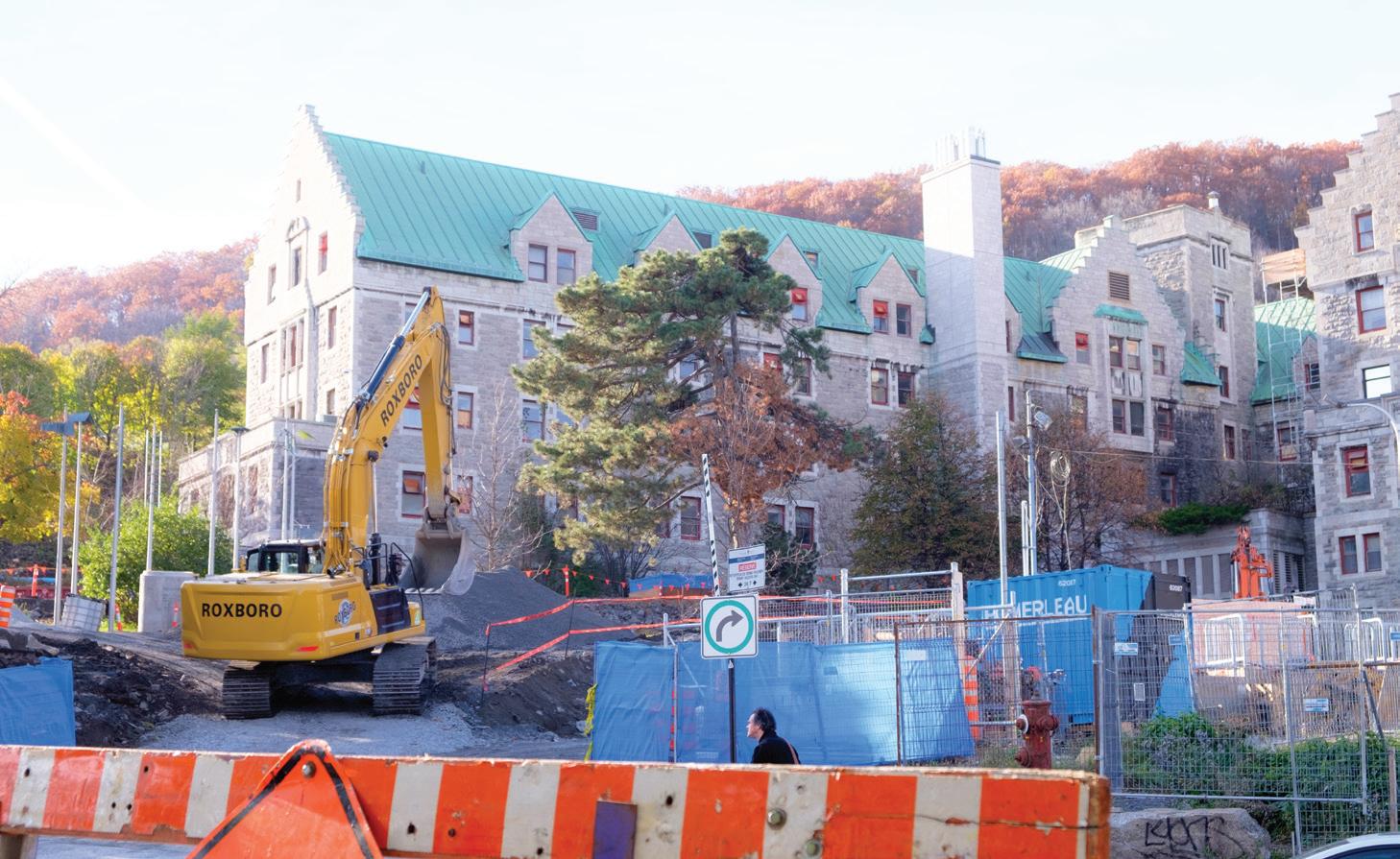 The Kanien’kéha:ka Kahnistensera (Mohawk Mothers) have been engaged in a legal battle with McGill University since Feb. 2022. (Mason Bramadat / The Tribune)
The Kanien’kéha:ka Kahnistensera (Mohawk Mothers) have been engaged in a legal battle with McGill University since Feb. 2022. (Mason Bramadat / The Tribune)
TUESDAY, FEBRUARY 27 2024 6 OPINION
opinion@thetribune.ca
Revisiting Lucy Maud Montgomery worlds
Montgomery’s work takes on new meaning during a time of environmental crisis
Kellie Elrick, Staff Writer
Ididn’t grow up by the sea. It’s strange that it elicits nostalgia from me—I hadn’t even visited the East Coast until last summer. But it also makes a lot of sense: I spent a good portion of my childhood within books, and many days with Anne Shirley. It started with the first Anne book. In a Victorian novel about Prince Edward Island (PEI), red hair, broken slates, raspberry cordial, and orphanhood, I found a depiction of childhood and the natural world truer than anything I’d ever experienced.
Growing up, Lucy Maud Montgomery’s island seemed to be refracted around me. Southwestern Ontario has a similar softness to it— rolling hills, blithesome rivers, land that’s open, but not flat.
I visited PEI for the first time in August. I wanted to see the place that had existed in my head for so long—there was a temptation to keep it that way, but my desire to feel close to Montgomery overwhelmed my fear of damaging my imagined idyll. I visited the major literary landmarks: Green Gables Heritage Place, the Lake of Shining Waters, Lover’s Lane, and the Haunted Wood. I dragged my boyfriend— who once told me he hated The Sound of Music because there was “too much music”—to see Anne and Gilbert: The Musical
Montgomery’s old church still stands (it’s now a fast-food joint called “BOOMburger,” but the original exterior has been preserved).
I felt closest to Montgomery in natural spaces—while walking along Lover’s Lane, gazing out at the sea, watching the breeze rustle the grass, looking out at ruddy, eroding cliffs, and anytime I looked at a tree for long enough. In these moments, I had the strangest feeling that I had been there before. And, in a way, I had.
Montgomery’s descriptions of nature are those of someone who has observed something very closely for a very long time. It extends into her prose itself: Blooming with mayflowers; warming with the break of day.
“I felt there was a rhythm in the language that resembled the land itself,” Dr. Elizabeth Epperly, a Montgomery scholar and Professor Emerita at the University of Prince Edward Island (UPEI), said in an interview with The Tribune. Epperly was born in Virginia—her love of Montgomery drew her to the island, where she enrolled as UPEI’s first student in 1969.
“The ocean has its own feeling of striving, standing on the shore,” Epperly said. “Mountains always at least make me feel like striving. They remind me of effort, and of climbing. But because [Montgomery’s] favorite passage was the Alpine Path [...] I always thought of the mountains, even the physical ones, as metaphorical [....] And so the ocean, deep as she goes—the illimitable sea—was for her, like the mountains.”
Returning to Montgomery’s novels in the past year, I began to see something that had glided past me before—over time, they take on a certain hardness. As Anne aged, something seemed to change. The darkening of Montgomery’s novels echoes the author’s own evolving worldview and personal trials—but also the fogginess of a society traumatized by the First World War.
“I don’t think [the war] changed her outlook on nature,” Epperly observed. “But I think it changed her outlook on human nature.”
Montgomery’s novels, beautiful and nostalgic, take on new meaning in the era of the climate crisis. The Great War destroyed large swaths of the natural world, and modernity brought about a certain kind of speed: Fast cars, skyscrapers, industry, new forms of communication—many of which are deeply intertwined with fossil fuels.
Montgomery’s writing is highly attuned to natural cycles. I’ve always loved how time passes within her novels: Fresh buds in spring,
mansion in Toronto that seems to atrophy. The house is said to have “died thirty years ago.”
Mistress Pat (1935), the sequel to Pat of Silver Bush, takes place over 11 years, when Pat—the heroine who Montgomery said resembled her most in spirit—is a young woman. The first year lasts 110 pages; then, as time goes on, each year takes up fewer and fewer page numbers. The 11th year lasts but 15. At the edge of youth, the days slowly begin to dissolve into the background. The novel ends with Silver Bush,
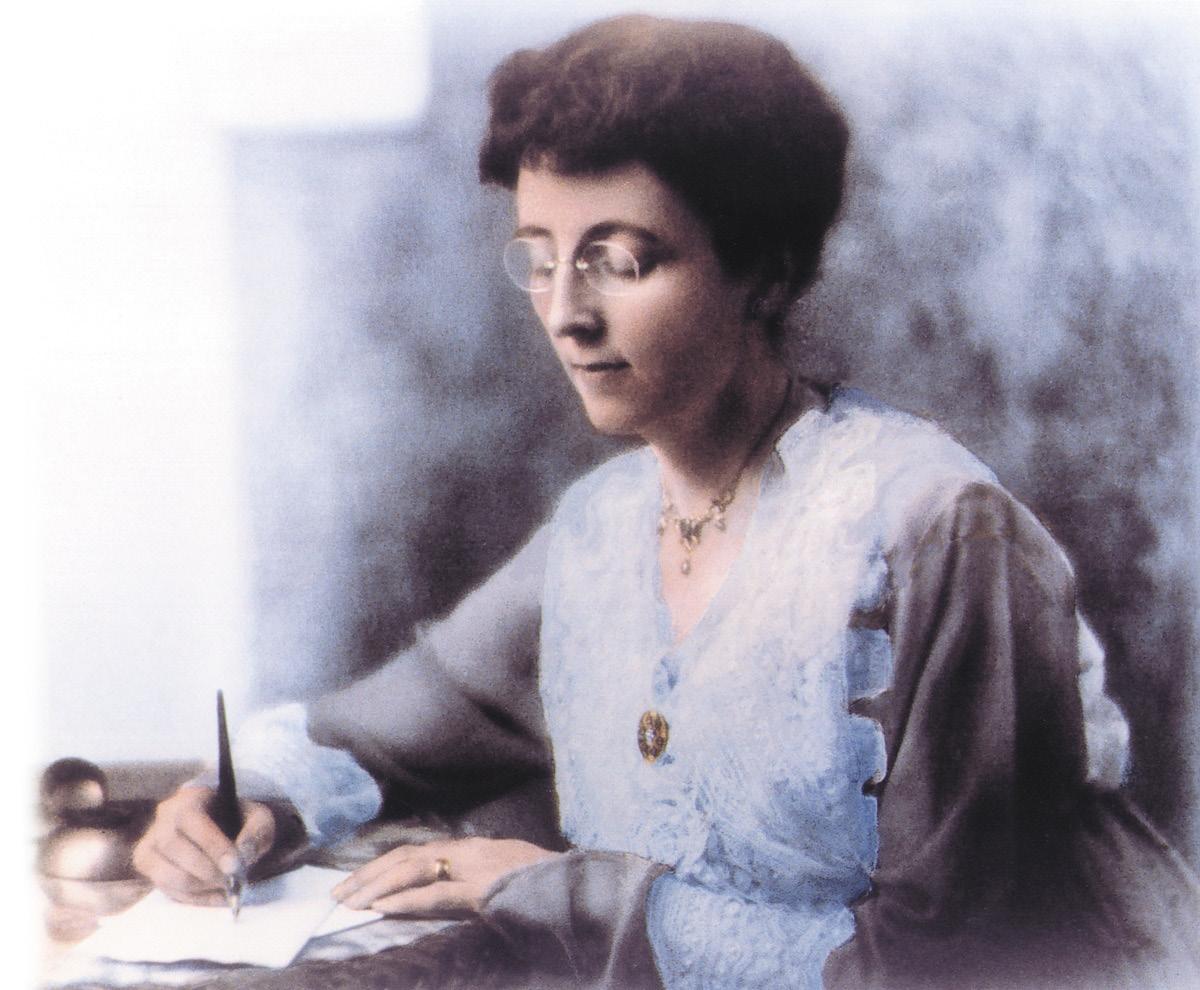

golden summers, fiery autumns, elegant lacy winters. But recently I’ve begun to notice something else: Decay.
When she left her beloved island upon marrying the Reverend Ewan Macdonald, she revisited the past through her fiction. Many of Montgomery’s works have a lovely stillness to them. They’re vivid and lively, but they displace the reader into a dreamlike bygone past, distorting time by standing still.
Jane of Lantern Hill (1937), one of her later works, opens with the description of a Victorian
After the war, after Montgomery lost a child, after she had left the Island, her writing changed. It’s as if the sun didn’t shine quite as bright upon her heroines—but she continued to write. And she found solace in nature, even as it was being destroyed.
“Montgomery believed that no matter where you were, you could find nature,” Epperly said. “You could, even if it was just looking in a flower pot, you know, seeing it there, too [...] It’s that feeling not that we’re escaping out of, but we’re escaping into.”
This June, Montgomery scholars and enthusiasts from around the world will gather at UPEI for the L.M. Montgomery Institute’s Biannual International Conference to escape into her work together over the course of five days.
“It is really such a wonderful event because it really feels like a homecoming,” Scarth said. “You know, whether or not you’ve been there before, because everyone has this shared love [....] It’s just a really collegial and fun and interesting space.”
Epperly’s keynote address at the Conference will incorporate Angus Fletcher’s Wonderworks: Literary Invention and the Science of Stories—exploring why we return to stories through neuroscience.
“No wonder we enjoy rereading all through our lives, rereading favorite books, because [...] the actual nerve hints are entangled and so you’re reading your old self as well as creating a new self while you’re reading it. It’s quite an interesting take on a neurological level,” Epperly remarked.
Montgomery describes a kind of veil. Something fluttering between the visible and the sublime, obscuring this world from something else, something untouchable, undefined. But there are moments when the veil blows aside.
“Amid the commonplaces of life, I was very near to a kingdom of ideal beauty. Between it and me hung only a thin veil,” Montgomery wrote. “I could never quite draw it aside, but sometimes a wind fluttered it. I seemed to catch a glimpse of the enchanting realm beyond— only a glimpse—but those glimpses had always made life worthwhile.”
There have been moments where I’ve felt something akin to “the flash.” Clear summer nights on Beausoleil Island on Georgian Bay, walking along the Speed River in Guelph at night after a fresh snowfall—for a moment, or maybe less, everything becomes hyper-sensory. Something else seems to emerge, not only out of the margins, but in the spaces between stars, between pine needles.
This sudden, fleeting escape into another world, a place that seems uncertain and phantasmal, but which I also know to be deeply true, is difficult to describe. The best comparison I can make is to say that this is how reading makes me feel.
Pat’s beloved home—essentially an extension of her own body—going up in flames. Place decays with life.
“Within the Pat books, there’s a reference to how all the bears have been gone,” Kate Scarth, Chair of L.M. Montgomery Studies at UPEI, told The Tribune . “I forget when the last bear was killed or died in PEI. But there is, you know, a sense in the novels of the community’s hands, of a world that has been dramatically altered.”
Through time, through conflict, personal and political, through the climate crisis, as seasons meld and familiar cycles spin out of control, as the past dissolves, upon each new read the wind lingers a bit longer, and the veil blows back a bit further, and Montgomery’s enchanted realm coalesces the slightest bit more with ours.
Montgomery should be read in childhood—and again in adolescence, and again in adulthood. Her works should be read to comfort and uplift, but also to confront and challenge. Every time I open one of her works, I discover something new that had just slipped out of view, and it makes me yearn to return to the island.
The theme of the L.M. Montgomery Institute’s 16th Biennial International Conference is “L.M. Montgomery and the Politics of Home” (KindredSpiritMichael / CC BY-SA 3.0 <https://creativecommons.org/licenses/by-sa/3.0>, via Wikimedia Commons)
arts@thetribune.ca ARTS & ENTERTAINMENT 7 TUESDAY, MARCH 12 2024
(Ross Dunn / CC BY-SA 2.0 <https://creativecommons.org/licenses/by-sa/2.0>, via Wikimedia Commons)
Home runs in a circular motion
Improvising spaces of shared serenity
As a kid with a penchant for playing house, I was always concerned by the ideal setup for community living. After much thought, around the age of eight, I decided that acquiring a barren piece of desert and erecting a flower-shaped cul-de-sac, with each petal boasting one house, would be most sensible for my purposes. Hastily, I drew up a plan.
Mika Drygas, Creative Director
I was enchanted by the American suburban promise of safety in seclusion, a concept graciously fed to me in the form of Bil Keane’s Family Circus comics. Drawn within a circle rather than the common square, an irresistible snugness contained each faithful ode to the nuclear family. A simple existence in a utopically peaceful neighbourhood, recurring every day for the comic’s six-decade history? I was sold.

Growing out of that sentimental illusion swung me dramatically in the opposite direction. My need for environmental novelty brought me to Montreal, and once I got used to life here, I moved on to Paris. In standard twenty-year-old style, my ultimate aim was to shoulder off any anchors and escape the confines of convention. However, after returning from my semester abroad, my appreciation for the community here blossomed, and I accidentally began to feel rooted.


I was then faced with the challenge of nurturing stability and a sense of being home while fending off the reverence for tradition that often underpins these sentiments. How do you establish a sense of permanence in a place when there is no promise that you, or your peers, will continue living there in a few years’ time? I brought the question to some articulate young folks with exceptional home-making faculties.
It’s hard to put into words… May I do an interpretive dance?


The home is our playground.

Home is where the hugs are.
These poetic remarks awakened me to the centrality of kinesthesia to the matter. Following the counsel of these experts, I turned my attention to how the desire to stay put manifests physically, and ventured to build a space that nurtures that feeling.
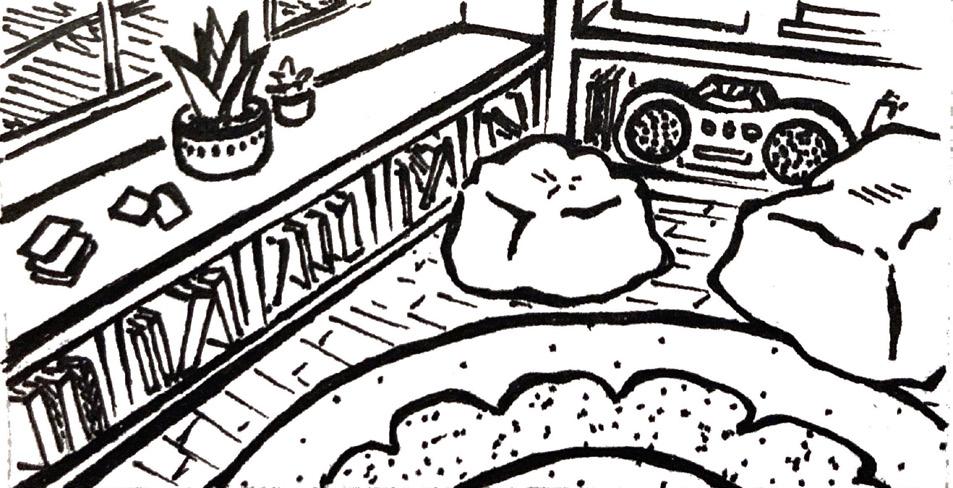
ENGL 472–Feminist Cultural Studies: Video and Performance, taught by Professor Celia Vara, was a research-creation cultural studies seminar that attended to the body in a way that I had not yet encountered at McGill. The environment reflected each student’s personality, and such tailoring required an overhaul of the classroom’s defining features. Often, the overhead lights were replaced by a coloured lamp, tables and chairs were displaced to serve the activity of the day, and soft drapes and blankets were brought in for physical ease. Music played as we worked.

A truly comforting space arrests the body, holding it in relief and allowing a heavy serenity, even sleepiness, to wash over it. Uncomfortable spaces can be arresting in the opposite way—the sterile white lighting and cramped plastic seating found in most lecture halls survey, rather than envelop, their students.
For Jocelyn Wong, a classmate and recent research-creation convert, spending a semester in this space altered her perspective on knowledge. “The research-creation method reframed my conception of learning from focusing on the result to being process-oriented,” Wong explained. “The environment for each of the group projects was curated to provoke specific feelings which would create each of the moods that were intended.”
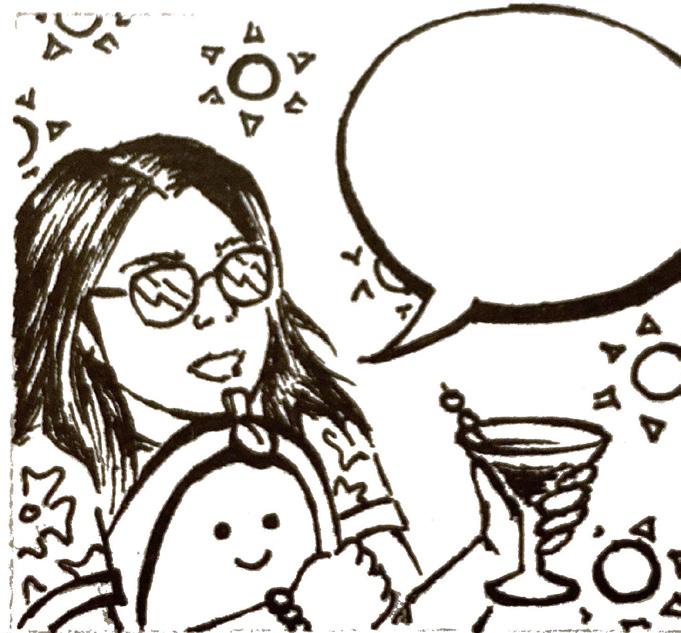
Why must you pester me on my vacation?
This mutable, emoting, and nourishing environment recalled the classrooms of my early childhood, where learning and playing were seen as one and the same. I came to understand that most successful learning spaces treat the classroom as a type of home.
Aleksi Kemppi
Aleksi Kemppi
Natalia Kolesnikow & Eva Lynch
A desire to reintroduce this wide-eyed warmth became the catalyst for my current fixation: Circle Time. An unruly spin on the joyful aspects of the classroom, Circle Time is a series of gatherings, primarily chez moi, which seek to nurture the kinds of knowledge that flow out of feeling safe and united with one’s peers. At Circle Time, we provide our attendees with gentle, undemanding stimuli—themed music and visuals, small and optional activities, and a lot of free space to gather and get comfy.
At Circle Time, the limiting social codes typical to a party scene are nowhere to be found. Chudakov explains: “We pay a significant amount of attention to the space in which our events take place, out of the belief that in a comfortable space, people take on a more open and inquisitive attitude.”
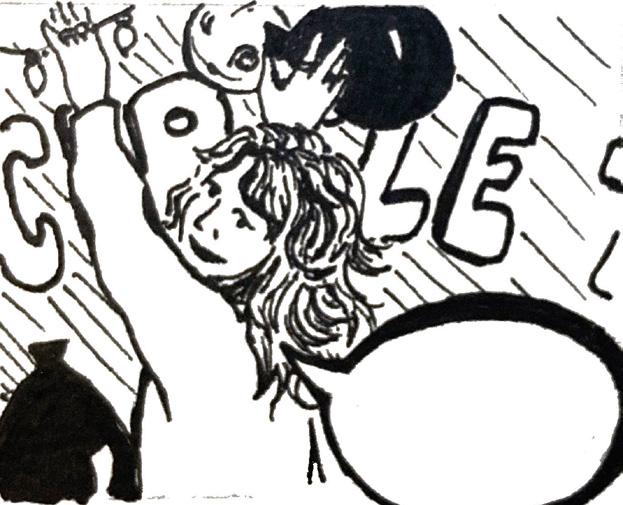
It has made me more of a constructivist.
I spoke to Anna Chudakov, my Circle Time co-conspirator, roommate, and Multimedia Editor at The Tribune, about the impetus for this style of event. “As someone who was raised with the Montessori method, the tactile element of learning was really formative, and every time I am in a typical classroom, I feel a burning lack. Every time I am forced to raise my hand instead of placing it on my teacher’s shoulder, a small part of me withers, and I am left to pine for more,” Chudakov generously shared. “Circle Time revolves around a return to playfulness, and cultivating a space of safety and curiosity where the participants can bring in an element of themselves.”
Opportunity to lay down and go silent abounds. In this regard, we draw inspiration from the 1990s vision of a chillout room. Providing dancers with a beanbag-padded, ambient musical haven, the chillout room was a feature of early rave spaces which the party cultures of today have largely abandoned.

There are, however, event organizers in Montreal who keep this fantasy alive in innovative ways. Sako Ghanaghounian, manabout-town and ambient sleepover specialist, is one of them. The first edition of S0undbath (now zzzzzz.club) transformed a loft space into a cloud-filled, downtempo dream world, made for drifting in and out of sleep. “The ambient events I’ve hosted in the past, particularly the sleepovers, draw heavy influence from chillout rooms that many raves would have in the ’90s and ’00s,” Ghanaghounian explained. “Unfortunately, parties in Montreal don’t normally feature side rooms where people are given the opportunity to collectively rest, immerse, and bliss out in such a way due to the limited amount of spaces and resources in this city–so why not just make it an event of its own?”
I totally felt this rejuvination...

Creative ideas always seem to flow in these states of half-consciousness, when the body is totally relaxed and the mind has long wandered off into a cloudy landscape. Making room for drowsiness is as crucial for innovation and exploration as it is for leisure—and this can be induced by the qualities of a space. Circle Time attendee and seasoned chiller Vivian Miyata noted, “I think it was the blue lighting that really did it for me. I felt like I was underwater, it felt like I could fall asleep at any moment […] it was lovely and beautiful.” For Ghanaghounian, the comfort of an event depends on having “ample room to move about without disturbing those around you, an abundance of spaces to rest so that you can endure the night, and very careful attention to the way the room sounds, with low amounts of lighting.”
Under the purview of Tourisme Montréal, access to this kind of awe and escape has become framed as a purchasable “immersive experience”—but collective rest and sensory nurturing don’t need to be mediated by a museum exhibit. The marketization of “chill out” products can lead us astray from the truly healthful pleasures of a comforting collective existence. By the late 1990s, music associated with the chillout room scene was co-opted by television programs and commercials which sold relaxation as a quick fix, fitting into a stressful schedule. Now, as the once-radical concept of self-care is increasingly linked to individualism and indulgence, we need to look for comfort elsewhere.
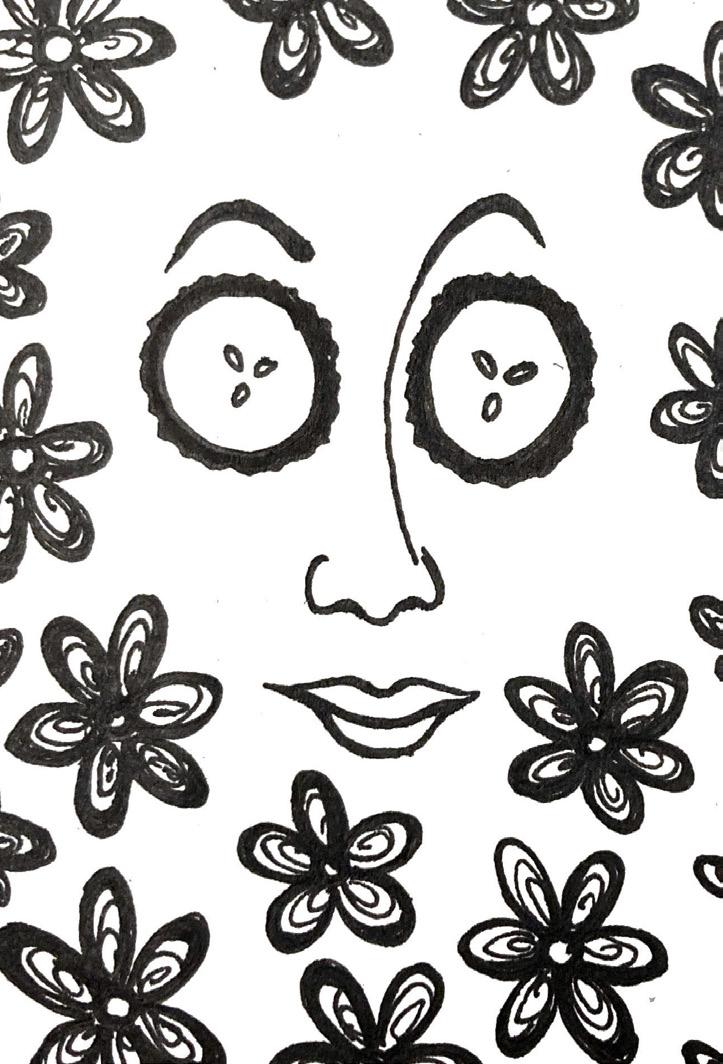
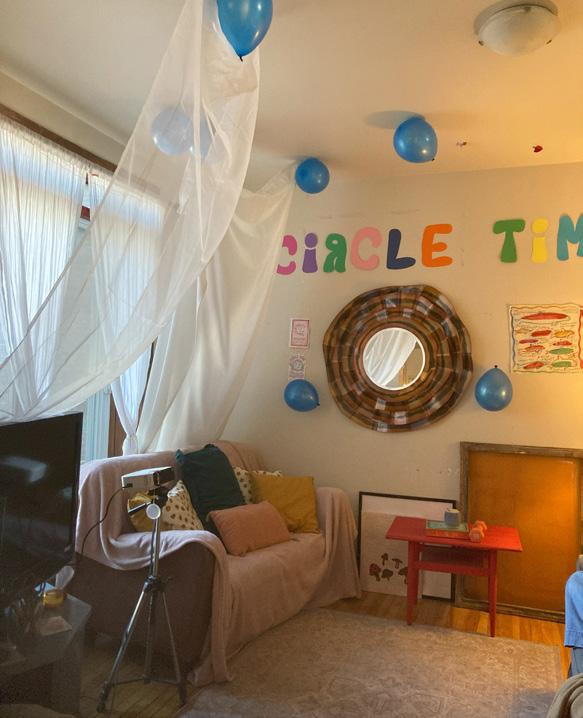
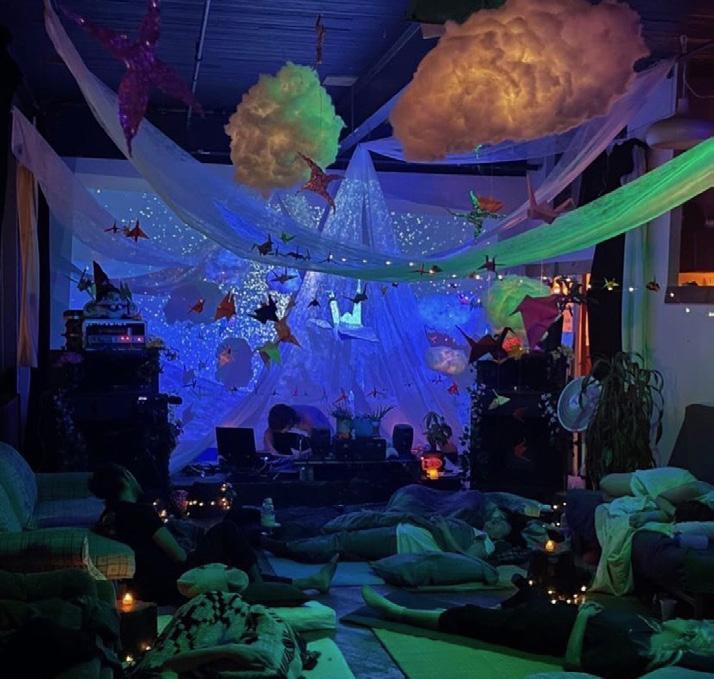

Circle Time was crazy… it felt like a weight was lifted off of my shoulders… or my chest, whatever the saying is.
As student-residents of Montreal, we can find ourselves at home by separating tranquility from removal, stagnation, and consumption. Crafting temporary “chillout” spaces for shared comfort provides a way to engage with homemaking and community-building that accommodates change and retains a forward-looking creativity. Contrary to expectation, you don’t need to invent your own suburb to build space for a peaceful togetherness—though I’m still not opposed to employing the flower as a template where possible. Wherever we are, we deepen our connection to place and with each other by gathering around— and learning from—rest.
S0undbath (Sako Ghanaghounian)
Setting up for Circle Time
The Children’s Hour is going home
Folk-rock trio unearths their lost album twenty years
Annabella Lawlor Contributor
As the bouncy plucks and resonant acoustics of the nylon-string guitar line underscore “Going Home,” vocalist Josephine Foster joins in, crooning, “I am going home.” Her vocal inflections are sweet and sombre, resembling the warbling mimicries of a lark as a spidery electric guitar melody spins between the interweaving words. The track straddles the line of loud and soft, balancing the mellow acoustic rhythms with moments of booming chorus brimming with melodious vocals and aching guitar harmonies. Foster sustains her operatic hums into
the song’s ecstatic and sonorous peak, crying soberly, “If you wait for me, my darling, I will wait for you.” Amid the culminating noise of the track, the melodic pattern of the song’s opening emerges isolated once again to resolve the album.
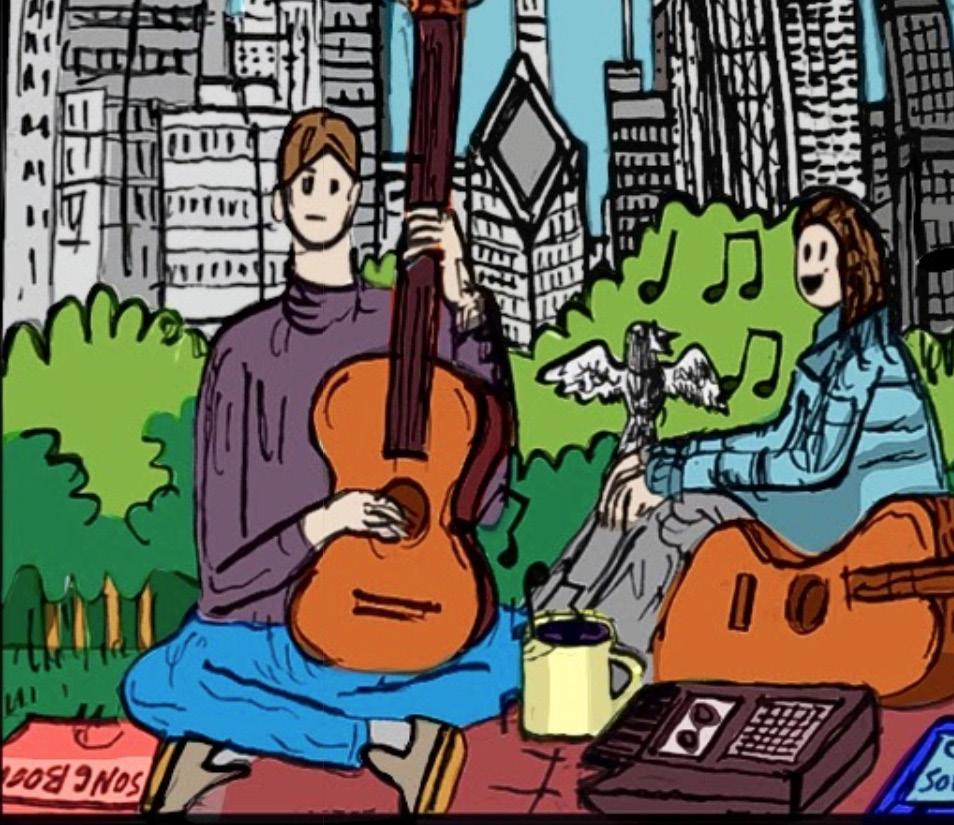
On Feb. 23, The Children’s Hour released their sophomore record, Going Home, two decades after its initial recording in 2003. Originally a duo, songwriters Andy Bar and Josephine Foster met the third member of their trio, David Pajo, at Chicago bar The Hideout while playing at a variety show in 2002. A member of the band Zwan at the time, Pajo befriended the pair after lending his guitar to Foster for their set, soon asking them to open for Zwan’s 2003 tour. For a louder sound fit to fill the depths of these large concert halls, Pajo joined Bar and Foster on the drums, producing new and distinct arrangements of songs the two had been playing acoustically since their conception. This album, recorded after the tour’s completion,
was lost for twenty years among the Kentucky studio’s tapes and archives.
In 2023, producer Paul Oldham finally unearthed the recording, and The Children’s Hour, now separated, reunited for the record’s mixing and mastering.
Going Home is a groundbreaking record brimming with nostalgia and eccentricity, familiarized by its traditional folk roots and poetic lyricism. The songs elicit the feeling of musical storybooks, comforting while invigorating in their structures and melodies. Throughout the album, there is an underlying sense of familiarity and connection that the band upholds through their partnership with symbiotic trust.
“We have a bond we’ve worked on,” Bar said in an interview with The Tribune. “I like playing with Josephine because I really respect her as a songwriter, and I learn from her as I’m playing with her as well.”
The album features an exploration of vastly different tonal narratives and genres. “Bright Lights” chronicles the sentimental yet celebratory final minutes of a person’s life, transitioning harmoniously into themes of gloom and reflective sorrow in “Rainbow.”
“This album is two kind-of shy kids singing songs together, what they come up with, and how they express
What we liked this reading week
later
themselves. We tried to write a dance song, like ‘Dance With Me,’ and it definitely comes from wallflowers,” Bar said. “I remember the day that I came up with that opening [for ‘Dance With Me’], I showed it to Josephine and it was kind of a fun moment. It was such a special song to us so I’m glad that it’s finally out on a record.”
“Dance With Me” is a whirling jive that explores and embraces introversion and stands out as one of the record’s finest. The unadulterated joy and amusement that emanates from this track is contagious, beckoning every listener to join the sea of twirling recluses and poetic angst.
On Mar. 23, The Children’s Hour will embark on their album release tour, playing two shows throughout the U.S. before finishing at The Hideout—the Chicago venue where it all began twenty years ago. The nostalgic sentiment that much of Going Home’s content evokes is further heightened by the circumstances of the record’s release. It celebrates the past, acknowledges the group’s accomplishments, and commemorates the band’s musical relationship. With Going Home, The Children’s Hour achieves a dreamlike soundscape of conviviality and liveliness, reminding us through music to savour every passing moment.
Hot Take
By Charlotte Hayes
For every second of Oppenheimer I enjoyed, I spent five thinking about just how long it was dragging on. I love movies and I love books, but I simply don’t think they’re a match. In nearly every movie adaptation, you end up with either one of two possible outcomes: Endless amounts of book material left on the cutting room floor, or over threehour-long slogs that drag viewers through every last plot point, which is the case for Oppenheimer and it’s source material American Prometheus
It only seems logical to switch all adaptations to TV shows—their sequential format allows creators to relish in the small details without making audiences sit through more than an hour of material at a time.
From reimaginings of the classics to fresh new indie pop, there’s something for everyone
In the End It Always Does by The Japanese House
Izzi Holmes
It’s time to give Amber Bain her flowers for In the End It Always Does . The Japanese House’s 2023 album opens with the pop synths of “Touching Yourself” and closes with the melancholic melodies of “One for sorrow, two for Joni Jones,” making Bain’s sophomore work the ideal soundtrack for a sunny winter day. Upbeat yet mellow tracks such as “Sunshine Baby” and “Morning Pages (feat. MUNA)” occupy literal and metaphorical space between these extremes, making for an experience that is both texturally complex and sonically cohesive. Though the British singer-songwriter’s honest lyricism seems bare in print—she repeats the title fourteen times in “You always get what you want”— her rich vocals complement the glittering instrumentals to ensure each repetition is more atmospheric than the last. Whether you feel like dancing or crying until spring rolls around, In the End It Always Does is the perfect companion.
Americanah by Chimamanda Ngozi
Adichie
Ava Ellis
Chimamanda Ngozi Adichie’s third novel, Americanah , is more than a love story. Winning the National Book Critics Circle Award for Fiction in 2013, the book captivated readers with its poignant exploration of race, identity, and belonging. Protagonists Ifemelu and Obinze are young
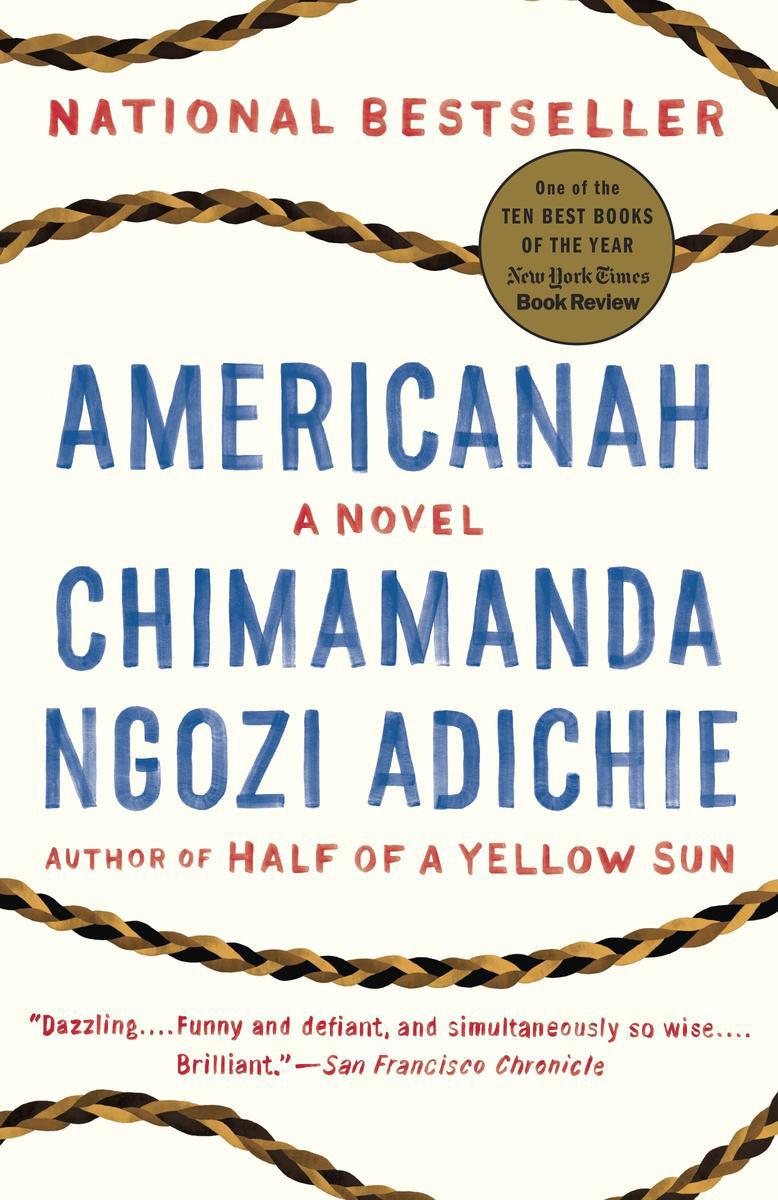
lovers faced with disruptive strikes at the University of Nigeria, which force them to emigrate for better opportunities. After moving to America to finish her studies, Ifemelu must confront both her distance
from her loved ones and, for the first time, what it means to be Black in the United States. While it is a lengthy love story, Adichie expertly narrates the immigrant experience in the West. Contrasting an undocumented Obinze in London and Ifemelu’s academic success in America, Americanah is an insightful and honest observation of race and how its social effects influence relationships on all levels.
The Idiot by Elif Batuman
Isobel Bray
Step into the world of Selin, a Turkish-American linguistics student at Harvard in the mid-90s, and the novel’s titular “idiot.” Selin’s world is moving from analogue to digital just as she herself is moving from teenagehood to adulthood. It’s easy to relate to her in this liminal space as she navigates friendships and a relationship with her classmate Ivan. The protagonist’s compelling narrative voice is a standout feature, often verging on streamof-consciousness. Elif Batuman’s prose, stark yet beautiful, captures Selin’s unfiltered dry humor and witty remarks. Selin is an observer, noting absurdities in the world to gain a deeper understanding of herself and where exactly
she fits. The novel is a coming-of-age rooted in academia, with Selin providing her thoughts on philosophy, languages, and literature. Selin swings between academic brilliance and social awkwardness, providing entertainment without dampening the story’s emotional resonance.
The Penelopiad by Margaret Atwood
Kellie Elrick
Mentions of sexual violence
When the novella begins, Penelope is dead. She has been for thousands of years. As part of the Canongate Myth Series , Atwood revisits the Odyssey through Penelope’s perspective; Odysseus’s dutiful wife, unfazed by hordes of persistent suitors, patient for her husband’s return, receives a new voice—and she wants to talk about the twelve maids (they appear, too, acting the part of the Chorus). Upon Odysseus’s return, he kills the suitors. But he also hangs the maids whom the suitors slept with, or, more appropriately, whom the suitors raped. Homer compares them to thrushes caught in a snare: Their feet twitch, and then they stop. The simile is beautiful; the scene is horrible. Atwood’s Penelope is all too aware of how slippery language is, reframing both Odysseus’s wiliness (Atwood’s Odysseus is a schmuck) and the orality of Greek epic. Penelope passes her afterlife in the Fields of Asphodel. So do the maids. Their feet still twitch. Homer’s Penelope weaves and unravels a shroud; Atwood’s Penelope weaves a tale, and refuses to let it go.
In 2017, Americanah won the ‘One Book, One New York’ campaign by New Yorkers (munrobooks.com)
Songwriters Andy Bar and Josephine Foster create a sen- timental sound using evocative themes of friendship and reminiscence. (Andy Barr)
arts@thetribune.ca ARTS & ENTERTAINMENT 10 TUESDAY, MARCH 12 2024
Patient-centric progress: Advancements in technologies for type 1 diabetes
How technology can lighten the burden of disease management
Yejin Lee Staff Writer
Living with diabetes goes beyond managing its symptoms. It involves grappling with social stigma, the necessity of a continuous supply of insulin, the lurking fear of hypoglycemia, and the financial burden of disease management in failing healthcare systems. Recent advancements in diabetes technology aim to assist with insulin adjustment and alleviate the mental burden diabetes patients face. A recently published paper titled “Exploring Technology’s Influence on Health Behaviors and Well-being in Type 1 Diabetes: a Review” features insights on such developments. This paper was written by a team of dedicated researchers including Meryem Talbo, a PhD candidate in McGill’s School of Human Nutrition.
Type 1 diabetes (T1D) accounts for approximately five to 10 per cent of all cases of diabetes. In contrast to type 2 diabetes, where insulin production is impaired, T1D is characterized by the complete absence of insulin production. This condition puts T1D patients in greater need of ongoing technological assistance.
“We do this research to serve the people,” Talbo stated in an interview with The Tribune, emphasizing the shift in the lab’s research focus from chronic or long-term complications such as glaucoma and renal failure to hypoglycemia
after consulting with a patient group.
According to patients, hypoglycemia—a condition in which blood sugar drops to a dangerously low level—is a more urgent and significant barrier as its symptoms are coupled with the chronic fear and anxiety of its development. The symptoms of hypoglycemia are categorized into three stages ranging from mild to severe, including convulsions, fainting, and loss of consciousness. Immediate treatment, typically involving administering rapid sugar or glucagon, is crucial but requires a trained healthcare professional who is educated on hypoglycemia treatment. This is a significant source of stress for patients, as the consequences are severe and support is not always readily available and reliable.
To address this concern for patients, the paper reviewed two main technologies used for the prevention of hypoglycemia and promotion of health behavior changes. The first is a continuous glucose monitor. It tracks glucose levels in the interstitial fluid—body fluid found in the spaces around cells—providing early alerts for potential hypoglycemia. The second is an insulin pump, which is currently more widely known. Because it delivers a consistent insulin dose through a catheter placed in the abdomen, the pumps are a less intrusive alternative to insulin injections. Recent advancements, particularly in automated insulin delivery (AID) systems,
integrate sophisticated algorithms, aiming to reduce management burden while promoting healthy eating habits.
“The ultimate goal is for the patients to sustain their lives without being inconvenienced by the disease, practicing health behavior [and] self-management,” Talbo emphasized.
Given increasing life expectancy and the lifelong nature of diabetes management, proactive disease management can prevent long-term complications and relieve economic burdens, benefiting patients in the long run.

The review extends to digital platforms in the global stage, showcasing TangtangQuan, an app developed specifically for T1D patients in China. This application provides a personal diabetes diary, dietary panel, diabetes education modules, and a peer support community. A cohort study including 693 adults with T1D observed glycaemic improvements after 12 months of app use. In North America, the Bolus Calculator app, developed by BC Children’s
Hospital, is widely used for determining the insulin dosage based on the nutritional composition of meals by using a photo-based insulin dosage estimation system.
The review highlights the life-changing power of these technologies but also emphasizes the importance of acknowledging patients’ needs and maintaining an open channel for feedback as they develop. The path forward involves continuous research, patient-focused solutions, and collective efforts to ensure an improved quality of life for those living with diabetes.
Upping the ante: The latest research on communication in ant societies
How these insects adapt biological processes to coordinate behavior in the colony
Ella Paulin Science & Technology Editor
On Feb. 29, McGill’s Department of Biology hosted a lecture on ant societies, led by Daniel Kronauer, an associate professor at Rockefeller University and a leading researcher in the field of ant evolution, genetics, and neuroscience.
“In my lab [...] we try to understand how ant societies have evolved, how they are organized, and how they function,” Kronauer said in his lecture.
To study ant societies, Kronauer’s lab breaks their research down into three major components: How the ants differentiate into different classes, such as workers and queens; how they communicate with each other; and how that communication leads to collective behavior, such as evacuating a dangerous area or exploiting a food source.
Kronauer focused on communication in his lecture, discussing how ants use insulin controls, fluid exchange, and pheromone sensing to send signals and coordinate their actions effectively.
First, he discussed insulin signaling, which is used in ants and other animals, including humans, to regulate chemical processes. The researchers knew that when an ant colony had young larvae, the adult worker ants had lower insulin levels than when they were in the egg-laying process, called the reproductive stage. The insulin levels in turn controlled worker behavior, such as foraging for food or laying more eggs.
But how exactly the insulin levels were controlled was a mystery. To investigate this, Kronauer’s lab removed larvae from one colony and inserted them into another.
“When you do that, what happens is quite dramatic,” Kronauer explained. “The larvae really regulate the insulin levels of the adults, so when you take the larvae out, insulin levels increased pretty rapidly, and if you add larvae to a colony in the reproductive phase that really suppresses it.”
Yet the question remained: How were the larvae regulating the insulin levels of the adults?
One possible answer lies in another communication method used by ants, fluid exchange.
This insight came from another experiment conducted by Kronauer’s lab, which involved separating the ants by developmental stage, so the pupae, larvae, and adult workers were all placed in separate enclosures. This allowed them to study each developmental state closely and in isolation.
“People have been regarding pupae as a more boring, passive state,” Kronauer explained. “But when [another researcher at the lab] started to isolate the pupae, she found that in the last week of metamorphosis, they started to secrete copious amounts of this clear liquid.”
Getting curious about this process, the researcher injected food dye into some pupae and placed them in an enclosure with adult ants. They found that the dye soon transferred to the adult ants, meaning that the ants must have been eating the liquid secreted by the pupae. Further, the adult worker ants would place young larvae on the pupae so that they could eat the liquid as well, providing a source of sustenance.
While this appears to be an important food source for the larvae and adults, it also seems to play a social role.
“The secretion is a pretty complex fluid. So there’s a lot of interactive substances in there, there’s a lot of hormones in there,” Kronauer said.
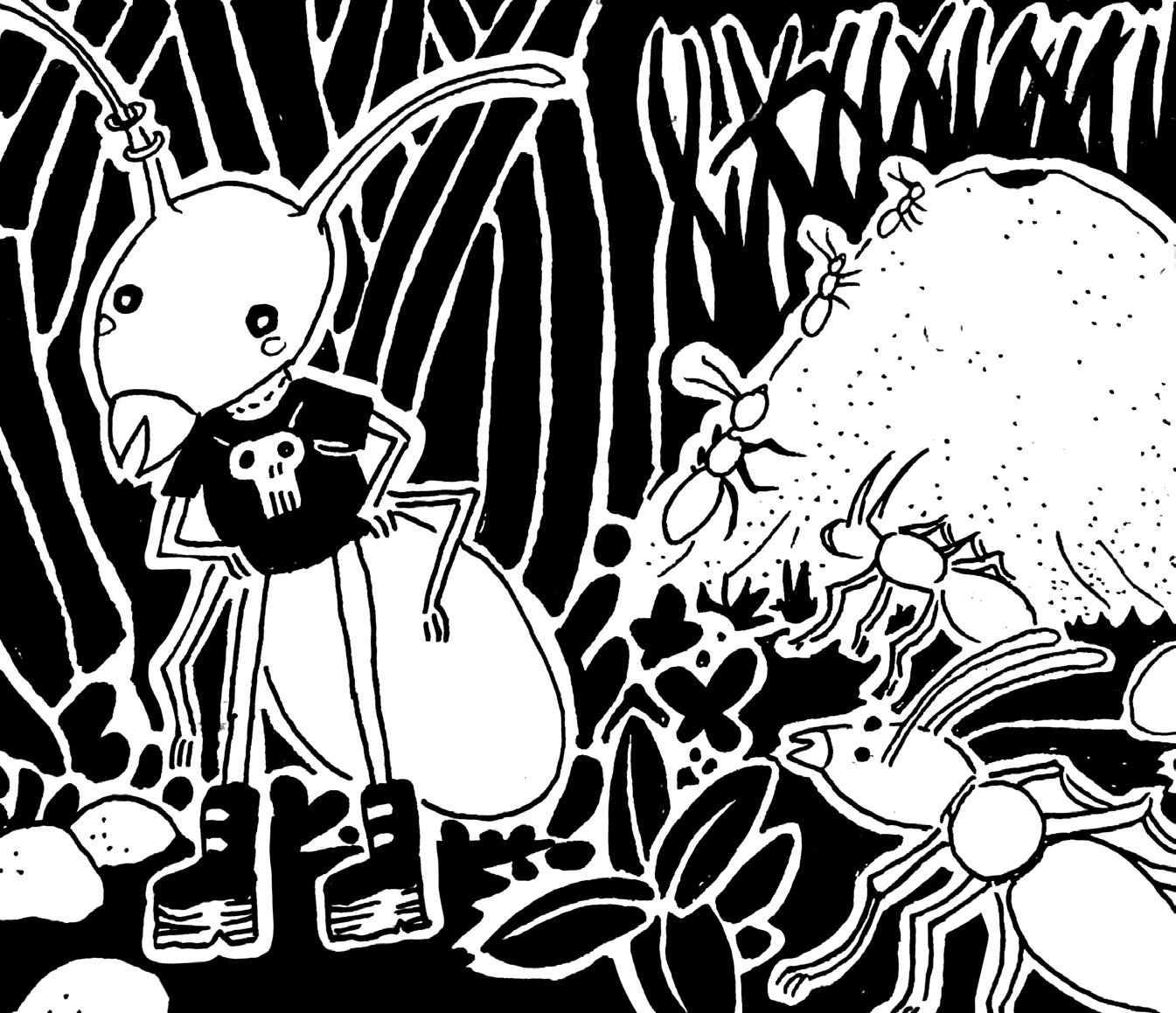
“So we think that it probably has a lot of important effects on both larvae development and also adult behavior.”
Finally, Kronauer looked at ants’ remarkable olfactory system, which has developed to perceive a wide variety of pheromones.
“When you look at ants, you’ll see that they are really just small walking chemical factories,” Kronauer noted. “So every worker species has about a dozen or so exocrine glands, which produce different types of pheromones.”
This impressive production of phero-
mones requires a large array of odorant receptors, about an order of magnitude larger than those found in fruit flies. Studying the neurobiology of this system is incredibly difficult and requires precise genetic testing. Kronauer’s lab made headlines by using CRISPR to create the first genetically altered ants.
What they found was striking: In ants where pheromone sensing had been interrupted, their behavior became completely asocial, failing to participate in collective behaviors and struggling to survive in the colony.
More than 8.4 million people worldwide live with type 1 diabetes, and its prevalence is projected to double by 2040. (Zoe Dubin / The Tribune)
TUESDAY, MARCH 12 2024 SCIENCE & TECHNOLOGY 11 scitech@thetribune.ca
Most of Kronauer’s research uses clonal raider ants, which are easy to propagate because they reproduce asexually, i.e. without a queen. ( Zoe Dubin / The Tribune)
Behind closed doors: How family physicians struggle against social inequities
Investigating the effects of proximity and moral distress in healthcare
Jenna Durante Contributor
Continued from page 1.
Monica Molinaro, a professor at the Institute of Health Sciences at McGill, investigated in this paper how family physicians navigate the challenges associated with providing care to patients facing social inequities. She also examined how sharing narratives from physicians may act as a form of support and resistance for other healthcare workers. Molinaro’s research specifically focuses on the implications of moral distress resulting from provincial policies, which have numerous effects on the healthcare system and the well-being of staff.
In her work, proximity emerged as an important factor in family medicine when extending care beyond the conventional boundaries of medical practice.
“The notion of proximity was originally conceptualized by nursing scholar Ruth Malone,” Molinaro explained in an interview with The Tribune. “Proximity comprises physical, narrative, and moral elements. Physical proximity involves being close to the patient and addressing their bodily needs. Narrative proximity entails understanding the patient as a human being. Over time, nurses transition to moral proximity, where they feel compelled to care for the patient based on shared values and beliefs about providing good care.”
In Molinaro’s study, physicians encountered challenges related to physical proximity,

More Ontarians will go without a family doctor unless immediate changes are made to provide support for family doctors. Approximately one in four Ontarians—that’s 4.4 million people—will be without a family doctor by 2026. (Karolina Grabowska / pexels.com)
which involved assisting patients in reconnecting with their bodies, especially those who had undergone medical trauma. Assistance included activities such as taking their blood pressure and temperature, helping patients to re-engage with their physical well-being through guidance and support.
Proximity in all forms, including narrative and moral proximity, serves as a form of resistance within family medicine. Physicians often find themselves motivated by moral proxim-
ity to go “above and beyond” their traditional roles.
Family physicians sometimes care for patients their entire lives, developing a high level of narrative proximity in particular. Through this care, they build trust over time and often feel compelled to take various actions, such as extending appointment times, to provide additional care to meet their needs.
The research emphasizes the moral distress experienced by physicians when they rec-
ognize the broader social systems that prevent them from fulfilling their patients’ needs.
“What is so morally distressing, is that they know what their patients need, but they can’t provide the care,” Molinaro said. “If a patient has issues with insomnia, due to chronic stress of racism, or colonialism, or sleeping rough in a shelter, there’s only so much a family physician can do within the scope of that in order to help.”
Addressing the chronic underfunding of clinics in Ontario and across Canada is essential for improving healthcare access for patients and alleviating the moral distress that healthcare workers experience. Family medicine and primary care are among the few freely available resources to many Canadians. This means that for many patients experiencing different forms of social inequity their family doctor could be the only professional who might be able to get them access to potential healthcare services.
“It is important to critique the structures because there are direct links between the way physicians are functioning and the way things are funded or the way policies are written or the way things are conceptualized,” Molinaro explained.
Molinaro’s research highlights the connection between moral distress and these broader systems and structures, along with the chronic underfunding of social welfare systems in Ontario. By examining these systems, Molinaro shows the need to develop new policies and practices, improving the future of healthcare in Ontario.
SciTech Reviews: ‘Superior: The Return of Race Science’
Angela Saini explains the resurgence of scientific racism.
Atticus O’Rourke Rusin Staff Writer
Science has helped society make sense of the natural world and all of its intricacies. Advancements in medicine, technology, and mathematics have all led to improvements in human welfare. At the same time, science can be applied unequally, benefiting those of a specific race or class, in ways that distort the field and legitimize racist ideas. One such example is making an unfortunate comeback: Biologically-based race science, or the study of racial difference, has reemerged after decades on the fringes. As Angela Saini explains in the 2019 book Superior: The Return of Race Science, race science has been rebranded and is now gaining ground in several academic circles.
To lay the groundwork for her argument, Saini opens by deftly explaining and demonstrating that race is not an identifier of intelligence, temperament, or any other complex characteristic. Saini makes clear that, in the scientific community, race is considered a social construct. Race realists, those who subscribe to the idea that race determines human variation, fight against those who they feel are ignoring real science in favour of political correctness.
Saini explains the first wave of race science in the middle of the 19th century asserted European racial superiority to justify slavery and colonialism. European scientists measured
skulls to determine brain size and assessed development based on the model of European cities, culture, and lifestyle. This eurocentric method of measuring advancement was obviously flawed, Saini argues, defining science by the views of the scientist. Race science further developed into the field of eugenics in the late 19th and early 20th century, taking off in the United State. The American eugenics movement included the forced sterilization of around 100,000 poor and minority women and was one of the models for Nazi Germany’s own horrific project of eugenics. Eugenics was “fashionable,” partly due to its association with science and scientific objectivity, Saini writes. The terrors of the Holocaust pushed eugenics out of the mainstream in the latter half of the 20th century, but a small circle of academics, who were invested in race research and had already made a name for themselves in the field, held on to the problematic idea that race determined a person’s inherent qualities.
In the 20th century, Saini writes, the misinterpretation of genetic data paved the way for a resurgence of race science, this time under the banner of race realism, which in turn conferred an increased sense of respectability upon it. By studying genomes of different population groups, scientists maintaining this ideology believe that they can find some inherent differences between races. Saini notes there is no evidence to support those claims. At the same time, enough mystery remains surrounding genetic determinants of intelligence and tem-
perament, that this has been used to support the possibility. It is thought that thousands of different genes may contribute to what we think of as intelligence, each potentially controlling a different brain pathway; however, only a small percentage of these genes has been discovered. Critics of welfare and equal opportunity in education use the perceived racial differences asserted by race scientists as evidence of the inevitable failure of such programs. They assert that discrimination and colonialism are not the causes of inequality but rather the result of genetic differences. The absence of definitive genetic evidence neither confirming nor denying “inferiority” is thus used as a shield for bigotry, in spite of the general consensus among scientists that race is a social construction.
Archaic humans, such as Neanderthals, were considered to be lower in intelligence than modern humans, or Homo sapiens. Europeans made the leap
that Neanderthals were, in turn, closely related to so-called “inferior races.” When researchers discovered that white Europeans share more DNA with Neanderthals than many of those they deemed inferior, Neanderthals experienced a sudden makeover. No longer were they our lowly ancestors, but our brilliant cousins. The scientist makes the science, spinning stories out of data, often in line with their biases.
 ( Zoe Dubin /
( Zoe Dubin /
SCIENCE & TECHNOLOGY
scitech@thetribune.ca
) TUESDAY, MARCH 12 2024 12
The Tribune
On the (internship) hunt How to navigate your summer internship search
Katherine Weaver Staff Writer
What are your summer plans?”
As 12-degree days start to make their way back to Montreal, so too does the topic of summer plans. How about an internship?
While internship application periods vary depending on the field, late winter can often be a busy period with many job openings being posted and deadlines looming. Here are some valuable tips and resources to help make this process a little bit less painful.
Set aside a dedicated internship day
With school and other responsibilities, internship applications can get lost in the shuffle. Time batching, when you set aside one day a week to focus on a particular task, will pay off in terms of productivity.
Head to a café or any location outside of your usual routine and allocate three to four hours to research and work on applications—you’ll thank yourself later for this commitment.
Get organized
Being organized before you start your search is incredibly important to help you stay on top of the entire process. Some may prefer project management software like Notion, while others may choose a simple
spreadsheet. Regardless of your platform of choice, having a central place that holds all relevant information such as the position and company name, required material, deadline, links to applications, and emails of contacts will prove invaluable.
It is also key to keep tabs on which materials you have sent to each application. You should be sending a tailored version of your CV and cover letter to each job, so when it comes time to interview, you want to know what information the interviewer has seen.
The search
There are many tried and true places to search for internships. First, there are public sites, such as Indeed, where users can browse and apply for internship postings made by companies. Another place to search is LinkedIn, a professional site where users can network, apply for internships, and be recruited by employers. One of the benefits of LinkedIn is the ability to connect directly with current employees at your companies of interest. This can help tremendously with not only your search but also with making your application stand out in the hiring process.
School resources, such as myFuture, Workday, and faculty-specific internship offices, provide a host of specific internship programs that are of interest to students.
Your McGill email is another great place to find internship opportunities, as faculty coordinators and professors will often forward openings to students. Setting aside a specific folder for these emails will help you make sure you don’t miss any opportunities.
Finally, don’t be afraid to use your McGill connections. Reaching out to professors, or alumni can be a great way to search for potential opportunities, and maybe even get a referral.
Or… create your own internship
Just because a company doesn’t have an internship posting doesn’t mean that they don’t offer one, or are not open to creating an internship program. Don’t be afraid of sending cold emails or making cold calls if you don’t see an internship available at an organization of interest. You can find tons of tips online for coldcalling effectively.
The applications
Applying to internships is a job in itself: It requires time and attention to detail. With enough practice, you’ll know how to tailor your
Ask Ainsley: Finding the perfect roommate
A guide to finding the other half of your future home
Ainsley
Dear Ainsley, We are already halfway through the semester and I will soon need to pack up my room in res to go home for the summer, but I still don’t know where I’ll be coming back to in September. Time has gone by so fast and I now realize that before even starting to look for apartments, I need to find my future roommate. But where do I start? Please help.
Sincerely,
Panicking Over Flatmate (POF)
Dear POF,
Don’t worry, I have been in your shoes and so have thousands of other students. You still have time. Finding a roommate is not something that you should rush. Here are a few tips to help you figure out who you’re going to live with.
Living with a friend?
It’s true that for some, living with a friend is the best way to find the perfect roommate. But for others, it breaks the friendship: You can be really close friends with someone and still not be made to live together, and that is okay—it doesn’t mean that you love the person any less. Sometimes, it’s better to live with someone you don’t know. That way, there are no expectations involved and no room for disappointment. It’s also a great way to meet new people. Remember to set boundaries and communicate and everything will work out fine.
CV and cover letter to each opportunity.
Highlight your past work, volunteering, leadership experience, and skills in your CV, while using your cover letter to explain why you are the best fit for the role.
Some final tips
Be creative. This is just one step in your long career process so it can be a great time to branch out and try new things. Finally, don’t be afraid to ask for help. McGill Career Planning Service (CaPS) offers students a host of resources, from workshops to career guidance appointments. You can get help at any stage in your search and application process, whether you’re just writing your CV or prepping for a final interview. Best of luck!

You can reach out to past interns on LinkedIn about their experience at your company of interest. (Maïa
Salhofer / The Tribune)
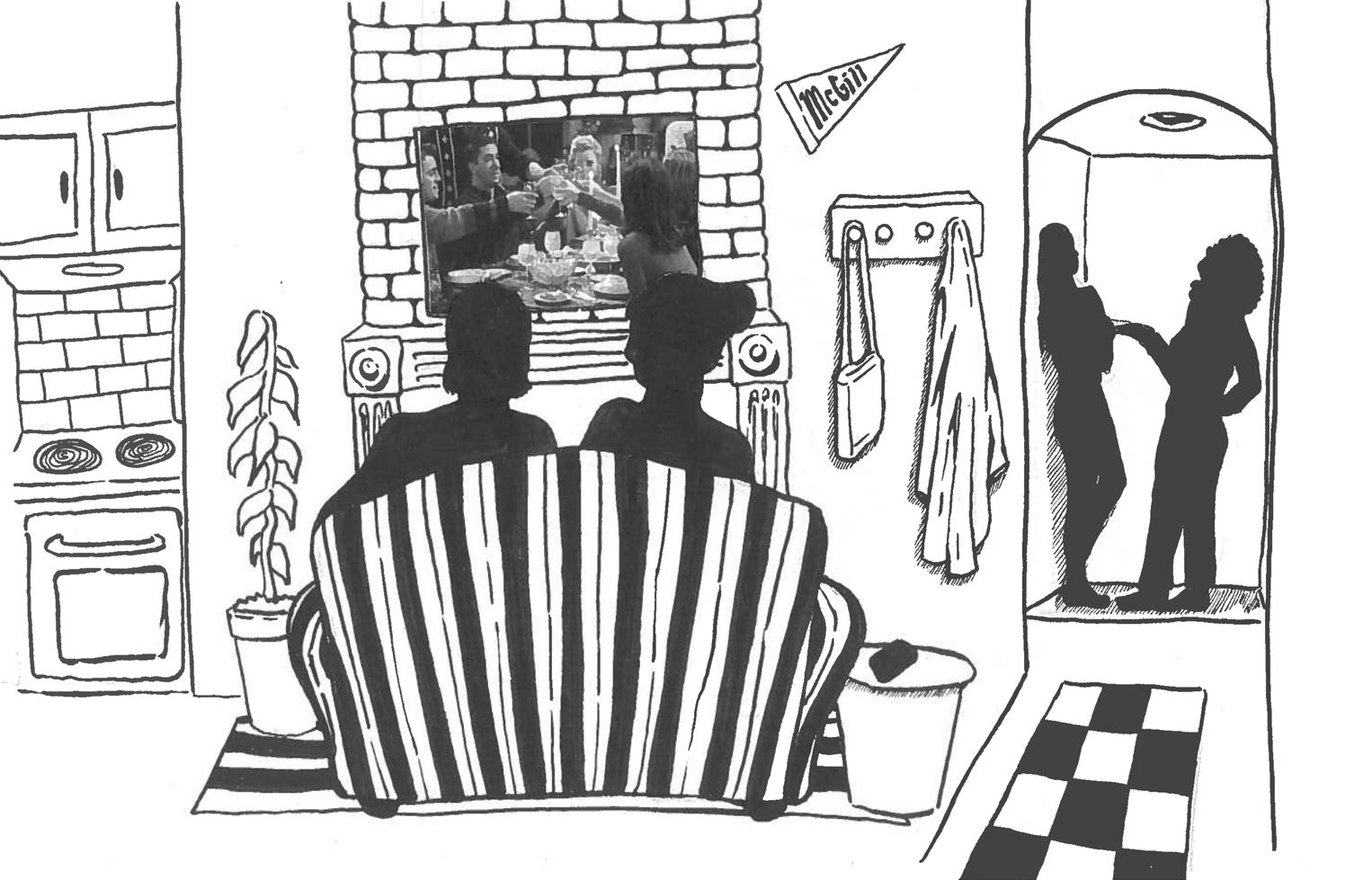
I would suggest living with a friend of yours only if their living style is compatible with yours. Otherwise, my biggest advice is to go to McGill Residences events. They organize a talk called Life Beyond Residences and you can be sure to find other people looking for roommates there, and they give great guidance as well. Apart from this, don’t hesitate to mention that you’re looking for a roommate to people around you—in your classes and to friends of friends for instance—and to check out some McGill Facebook groups as well.
Cleanliness
Who in this world actually wants to
live with someone dirty? I know I definitely don’t. It is crucial that you and your future roommate agree on the cleaning processes and boundaries. My roommate and I agreed when we moved in together that the dishes should be done immediately after eating if possible, or should not stay more than 24 hours in the sink. This is what works for us. Find what criteria work for you and make sure your future flatmate agrees. It can be really irritating to live with someone who doesn’t care as much about cleaning, or who cares far more about it, than you.
Social battery levels
If you lived in residence with a room-
mate during your first year you know how important having a compatible schedule is. As someone who likes staying at home with a book and a cup of tea on Thursday night, you might not want to live with a party animal—and vice versa. I recommend finding someone who matches the way your social battery level fluctuates. It’s fine if you do not always want to do the same things but trust my word on this: It’s not nice coming home after a long day of school wanting to go to bed early to find your roommate partying in the living room.
Complementary habits
Cooking together is a great way to bond with your roommate at the beginning of your shared journey. While it’s always nice to discover someone else’s go-to food, my advice is to find someone who has pretty similar taste as you do—especially if you are a picky eater. If you don’t like cooking then you might want to find someone who does and would be down to prepare delicious meals for the both of you. In exchange, you could offer to handle the dishes for instance. Either way, the perfect roommate should align with your preferences.
I hope this helps. Signing a roommate agreement might also be a good idea in order to put your standards for each other into writing and avoid a mid-semester crisis. Don’t forget that the only person you are going to be living with for the rest of your life is yourself—you are your own perfect roommate— so don’t stress too much about finding the perfect roommate when your stay with them is not going to last forever.
“ STUDENT LIFE TUESDAY, MARCH 12 2024 13 studentlife@thetribune.ca
Whether good or bad, you’ll never forget your college roommate. (Abbey Locker / The Tribune)
Matthew Molinaro Editor-in-Chief
Continued from page 1.
Tribute: Remembering Professor Monica Popescu
Friends, colleagues, and students reflect on the intellectual’s legacy
Below, Monica’s students, colleagues, and friends share their memories of this beloved scholar.
Monica Popescu made so many things possible. She was one of the most brilliant and insightful scholars I’ve ever met—and also one of the kindest, most down-to-earth, and committed friends. During our twelve years together at McGill, we published, edited, and organized several transformative books and symposia. She brought celebrated writer, activist, and professor Ngũgĩ wa Thiong’o to McGill—a watershed. We shared jokes, stories, lunches, karaoke sessions, birthday celebrations, and walks.
And there was so much more work left to do. Her loss leaves a yawning abyss. Its pain ripples through all the lives she touched. I know that Monica’s legacy will live on through our work and our tributes.
– Katherine Zien, Associate Professor, Department of English
“It is a truth universally acknowledged” that Monica had a deep love of Jane Austen and a penchant for all things Regency. We never got to attend a Jane Austen theme weekend at the Governor’s House in Vermont or to co-teach a course on decolonizing the Regency, as we had hoped. But “let other pens dwell on guilt and misery.” Austen wrote that “perfect happiness, even in memory, is not common” but attending the immersive Bridgerton ball experience with my dear friend was one such moment of perfect happiness and a memory that I’ll always cherish.

ator and a dear, dear friend.
We all know of her formidable scholarship but what may be less obvious is how warm and generous she was to others; how encouraging of others as they pursued their own lines of thinking. Monica embodied warmth, joy, and laughter, and was one of the kindest people I have had the privilege to call a friend. And she was funny. I recall one Montreal winter evening she arrived late for drinks: “Sorry I got late,” she said as she entered the bar on Avenue du Parc. “I slipped on the snow and fell—I think I am a fallen woman now.”
This was just one of the many memories I have of sharing a meal or a drink (often several drinks) with her. These moments were times to catch up and compare notes: about course texts and syllabi but also about new restaurants in Montreal and possible endings to the Game of Thrones (Monica preferred the novels to the television show). She initiated me to the joys of mici, the Romanian sausage, on one such outing; on another, I introduced her to the classic Bollywood song “Monica, my darling.” Her laughter at seeing the video—the legendary Helen, twisting and twirling to the words—still rings in my ears. Monica leaves us poorer—I miss the warmth, joy, and that sparkling laughter that she brought to all our lives. She was, simply put, wonderful. Or as she would have said, in that incantatory joyfulness that was so singularly her: “wonderful, wonderful, wonderful!”
– Sandeep Banerjee, Associate Professor, Department of English
– Fiona Ritchie, Associate Professor, Department of English
Monica came into my life ten years ago and we felt close almost instantly. Her easy laugh and generous, heartfelt compliments broke your defences and brought out something more elevated in people she encountered. She infused a vibrant and joyful spirit into the academic projects we embarked on together. Monica had a talent for deep literary readings fused with a critical historical analysis. She brilliantly expanded the field of Cold War literary and cultural studies, a legacy that we must all strive to uphold and amplify.
– Bhakti Shringarpure, Associate Professor at the University of Connecticut
Professor Monica Popescu was a phenomenal and humane person and a stellar scholar. Monica possessed a profound respect for African literatures, and she shaped generations of students at McGill. Monica was an exemplary educator. Her love of Africa infused the African Studies Program with a weight and intellectual gravitas belied by its still limited resources. Whenever Monica was around, we all knew that African Studies had a home and that it had a future at McGill. Such was her electric energy that she almost single-handedly centred Africa on campus. The renowned Nigerian writer, Chimamanda Ngozi Adichie, famously warned of the danger of Africa being contemplated in terms of that ‘single story,’ that single narrative, and how
this often robs readers and writers alike of understanding Africa’s full diversity and humanity. Monica never needed to be taught that cautionary tale. At McGill University she taught all of us that this particular lesson was as profound as commonsense.
– Khalid Medani, Chair of African Studies
As everyone who knew her will attest, Monica Popescu was a profoundly capacious human being. In addition to being a brilliant and groundbreaking scholar, she was incredibly generous in mind and spirit. Monica wanted her students to have the opportunities that she had, and she went out of her way not only to open doors that would have remained closed but to devote her energy to transforming their minds and lives. Within the Department of English, I always thought of Monica as the “gold standard.” What I mean by that is that I always felt that her intelligence, political beliefs, and ethical integrity were the keystone to our department. Monica proved that one could be at the very top of their scholarly field without sacrificing time for their students, or one ounce of their kindness. She was also a dear friend, who was always so supportive of every one of my endeavours. I loved her and will miss her beyond measure.
– Ara Osterweil, Associate Professor, Department of English
“I am so glad you could come—I have heard a lot about you from common friends.” These were Monica’s words to me when we met for the first time—in the corridor connecting Arts to Leacock, during my campus visit in February 2013. In a few months, Monica became my departmental colleague and fellow “postcolonialist” (notwithstanding, as I was soon to realize, that we shared a disdain for that term). But she was also, as I would call her, my fellow co-conspir-
Monica probably had the premonition that she wasn’t going to be here forever, so she packed the goodness of five lifetimes into just five decades. Unarguably the kindest academic I ever met. Sad that I knew her too late. Sad that she had to go the way she did.
– Onyeka Dike, MA ‘23
Of Stars and Grief (for Monica Popescu, 1973-2024)
I started this note without tears in my eyes
I started this note with a kind of beautiful denial
I started this note from a place some of us have known: grief—that city we must all reach, that unmapped terrain.
I refused to believe Monica is no more, that Brasov’s pearl lies still
I cannot imagine that she will sleep subterraneanly somewhere in the city
I am haunted by Monica’s eternal silence
Even my words are reluctant in their acceptance: Monica is no more—her breath is history.
My people say that those the gods love do not live long They kiss the world just enough to complete their mission They leave us, we who outlive them, with a rare gift: A lifetime of the best memories, a bowl of endless affects
From the mountains of Transylvania to the estuaries of Pennsylvania
From the prairies of Windsor to the rapids of the St. Lawrence: Everything and everyone bear testimony to Monica’s existence
The favourite of the gods and of mortals: Monica lived We all testify with tears in our eyes.
Mathias Orhero, PhD candidate in the Department of English
STUDENT LIFE 14 TUESDAY, MARCH 12 2024 studentlife@thetribune.ca
Popescu’s monographs South African Literature Beyond the Cold War and At Penpoint: African Literatures, Postcolonial Studies, and the Cold War garnered worldwide acclaim. (Monica Popescu)
Public subsidies for sports facilities are a misuse of public funds
Utah’s new stadium funding package continues a legacy of Major League franchises terrorizing municipalities for profit
Sara Escallon-Sotomayor
Sports Editor
Marco Zeppilli Staff Writer
In recent decades, city and state governments across North America have earmarked huge amounts of public funds for sports infrastructure projects. As part of the legislative session that ended on Mar. 1, Utah’s state lawmakers passed bills approving $900 million in funding for a baseball stadium and $500 million for a new hockey arena in Salt Lake City. Utah has neither a Major League Baseball (MLB) team, nor a National Hockey League (NHL) team, but the legislature was evidently not interested in letting present-day reality stop them from funding the potential presence of future big league teams.
Public subsidies for privatelyowned sporting facilities have been a perennial headache for elected officials. Privately-owned men’s sports teams threaten underfunded municipal governments with relocation if they do not receive generous financial packages to fund exorbitant stadium infrastructure plans complete with incorporation into public transport systems, resulting in a humiliating ‘race to the bottom’ at taxpayer expense. Funds are committed to attract lucrative men’s major league professional sports teams, rather than invested into women’s, grassroots, or other levels of sports, and single-team stadiums are common, meaning the investment needed is often multiplied two or three times depending on the number of teams a city has.
Governments have allotted eye-watering amounts of public dollars to build stadiums in recent years. These subsidies include building new facilities at the taxpayers’ expense for existing teams that already have functioning stadiums. New stadiums are built to increase profitability as they contain higher percentages of more lucrative seating, such as luxury suites. These profits then flow into the pockets of ownership groups rather than back to the city or local community. If these stadiums aren’t full, franchises will often leave regardless of investment, hoping to increase profits in other markets. For instance, the state of Tennessee and the city of Nashville are contributing $500 million and $760 million respectively to a new stadium for the National Football League’s (NFL) Tennessee Titans.
The Buffalo Bills scored $850 million in funding from their state and county for a new stadium. Oklahoma City residents passed an $850 million funding package to replace a 22-year-old basketball

arena in a public referendum that totalled 58,000 votes. The list could go on, but the pattern is clear.
Hidden costs, invisible benefits
In negotiations for public subsidies, team owners typically cite the community benefits that these infrastructure projects can provide. Friends and families can create lifelong memories at the live events these stadiums host. The argument that communities need these facilities in the same way they need public swimming pools, libraries, and museums is understandable.
The problem lies in the staggering dollar amounts contributed to these facilities— especially in cases where infrastructure already exists. When large-scale sports infrastructure projects are funded to the tune of hundreds of millions of dollars but governments leave roads and bridges in disrepair, fail to provide adequate support to underfunded school systems, and neglect entire networks of overcrowded, shortstaffed hospitals, officials are failing those they are elected to serve.
Prospective owners claim that tangible benefits for communities and governments come in the form of an increase in economic activity and tax revenue as a result of these projects. They suggest that tourists will occupy hotel beds, eat at restaurants, and contribute to the local economy when they are in town for sporting events and concerts. However, studies have shown that the economic impact of tourists visiting a city specifically for a single live event is negligible,
and, in most cases, those tourists would still visit and be contributing to the local economy in other ways.
The environmental impacts of sports stadiums are almost never considered. Stadiums, such as Los Angeles’s SoFi stadium, are often built on land at the fringes of urban areas which previously were green spaces. These stadiums require transportation infrastructure built with public funds, and result in emissions from fans driving cars. Despite stadiums becoming increasingly energy efficient, huge amounts of energy remain necessary to power operations, and tonnes of waste are created with each event. Increasingly, teams such as Everton in the Premier League are choosing to build new stadiums rather than update old ones, as Liverpool did with Anfield. Concrete production and construction generate huge amounts of carbon dioxide, and in a climate crisis we must ask ourselves: Is this really what we want to spend emissions on?
Breaking ground by sharing grounds
While teams may find the prospect of operating their own facilities appealing for the bottom line, they should consider using existing facilities or holding their events in venues that are already being used by other local teams. For instance, basketball and hockey arenas are often shared— as is the case for soccer and football stadiums—as the seating configuration is similar enough for those sports’ purposes. Yet there are many cases where soccer-
of Utah, the most popular sport is college football. Are state residents really clamouring for more professional men’s sports teams?
When franchises leave, it is local communities who lose. Afterall, the capital investment is transitory: Ownership groups do not need to take on expensive stadium build costs or deal with the legacy that these crumbling concrete monsters leave behind in their communities. Ownership groups also do not feel the traumatic repercussions which reverberate throughout communities when much-loved teams leave. Elite sports franchises can be synonymous with community investment but not intrinsically so.
specific stadiums are being built for Major League Soccer (MLS) teams in cities where an NFL or college football stadium already exists, including New York City and Miami. While team owners in those cities are funding their projects with private dollars, it is estimated that the deal in New York will cost $516 million in lost property tax revenue over 49 years by leasing the land to developers instead of selling it, while the Miami club is benefiting from a no-bid lease agreement. Teams are also looking for considerable sums to fund renovation projects or, worse yet, ditch their existing stadiums, even in cases like Oklahoma City’s, where the stadium is not yet 30 years old. In these cases, public funding packages yield no added community benefit, as adequate infrastructure already exists.
Not every city needs to play in the big leagues
North American sports franchises are notorious for moving cities as soon as it is no longer lucrative to remain in place. The reality is that not every city has a market for a major team in some of the most lucrative leagues in the world. As soon as attendances drop, a franchise’s viability is at risk—a fact that supporters of the Oakland Athletics and the Winnipeg Jets know all too well. The value of sport to local communities is not in question: But does every city need an NHL team? Utah is a state of 3.4 million people which is already home to the NBA’s Utah Jazz and MLS’s Real Salt Lake. According to this 2014 survey by the University
Most cities do not have the capacity to support more men’s major professional sports leagues: Athletes are overworked, and more and more games are being fit into increasingly tight schedules. We need more investment outside of the status quo: into burgeoning women’s sports leagues such as the NWSL and the WNBA, into second and third division development leagues, into grassroots sports, and into youth development pathways. The strength of the National College Athletics Association (NCAA) means that many development leagues are little more than an afterthought. However, for sports such as baseball and hockey, minor league teams are vital community institutions. One of those minor league teams is located just south of the border, in Burlington, Vermont, where the Lake Monsters, a former affiliate of the Montreal Expos, continue to honour their parent club’s legacy during a theme night, taking the field in Expos colours. In other countries with competitive league pyramids decided by promotion and relegation, small town teams may never get to the top, and that is fine. They are proud community institutions with deep roots. When they do make it to the top, as Luton Town did last season, it means all the more, as the fairytale has come true.
The last thing we need is for more municipalities to be held hostage by corporate greed. Private ownership groups bully elected officials by leveraging their franchise mobility against the best interests of communities, wrecking everything in their path. It is time for local governments to be brave and stand up to private ownership groups for the benefit of those who really matter—the supporters. The Green Bay Packers are living proof this model can be achieved even in North America. After all, a team is not a team without a community rooting it firmly in place.
<https://creativecommons.org/licenses/by-sa/3.0>,
SPORTS 15 sports@thetribune.ca TUESDAY, MARCH 12 2024
The NFL’s New York Giants MetLife stadium built next to the now-defunct Giants stadium in 2009. (Gregory J Kingsley / CC BY-SA 3.0
via Wikimedia Commons)
Varsity Roundup: March 1-10
The Tribune catches you up on what you may have missed in McGill sports last week
Tillie Burlock Sports Editor
While some McGillians jumped on a plane for a beach vacation, headed home, or found a way to make a stay-cation work in Montreal for reading week, the Redbirds and Martlets remained hard at work.
On Friday, Mar. 1, the Redbirds (21–5–2) hockey team bounced back from their gameone loss to the Université du Québec à Trois
Rivières (UQTR) Patriotes (21–6–1) in the Ontario University Association (OUA) East men’s hockey best-of-three series. With their season on the line, the Redbirds looked to stave off elimination and push the series back to McConnell Arena. Despite going down 3-0 just seven minutes into the first period, the Redbirds dug deep with Eric Uba scoring three unanswered goals to register a hat trick. With the game tied at three, Zach Gallant netted what would be the game-winning goal with just under two minutes remaining. As four seconds remained on the clock, Mathieu
Gagnon scored the final goal of the game resulting in a 5-3 victory for the Redbirds.
Unfortunately, for the Redbirds fans who remained in Montreal, McGill could not find the same magic in game three of the series. The Redbirds fell 4-0 to the two-time defending league champions, leading them to face off against the Brock Badgers (21–7–0) in the OUA bronze medal game on Mar. 9. The Badgers, who finished first overall in the OUA West’s regular season, fell to the Toronto Metropolitan University (TMU) Bold (19–9–0) in the OUA semi-final. The Bold went on to lose 3-2 in double overtime to the Patriotes in the OUA finals. As for the Redbirds, they successfully defeated the Badgers 5-2 with goals from Uba, CharlesAntoine Dumont, Caiden Daley, and William Rouleau. McGill will play next at the U SPORTS National Championship hosted by TMU from Mar. 14-17.

In the pool, McGill hosted the U SPORTS National Championship where the Martlets finished fourth overall and the Redbirds claimed bronze. The Martlets’ competition was highlighted by Naomie Lo snagging a silver medal in the 400 m freestyle. As for the Redbirds, Pablo Collin flourished yet again, taking home gold in the 200 m freestyle. Collin, Artiom Volodin,
Know Your Sport: The McGill Woodsmen saw it all
Bruno Dehem-Lemelin, and Mats Baradat earned the Redbirds their second gold medal in the 4x200m freestyle relay. The Redbirds also medalled in the 4x100m freestyle relay while Malachy Belkhelladi took home a silver in the 50 m freestyle and Hazem Issa added a bronze to McGill’s medal tally in the 50 m butterfly. Baradat also claimed a bronze medal in the 400 m freestyle. The Redbirds’ third-place finish with 898 points was behind the University of Calgary’s 922.5 and the University of Toronto’s dominating 1,145 points. As for the Martlets, their fourthplace finish was with 788.5 points while the University of Toronto claimed 1,444 points, just ahead of the University of British Columbia’s 1,300 and the University of Calgary’s 872.5.
On the track, McGill travelled to Winnipeg for the U SPORTS Track and Field National Championship. The Redbirds finished fourteenth overall while the Martlets finished sixteenth overall. In terms of medals, Matthew Beaudet earned silver in the 3,000 m with a time of 8:01:44 and snagged a fifth place finish in the men’s 1,500 m. Donna Ntambue took home a third place finish in the women’s 60 m and helped carry the Martlets’ 4x200 m relay to break the McGill record by 1.5 seconds. In the men’s 4x800 m, the Redbirds earned a fifth place finish and round it all out, Kilty McGonigal took home a fourth place finish in the men’s heptathlon and set a new Redbirds record.
McGill’s Macdonald Campus hosts its 62nd Annual Woodsmen Competition
Julie Ferreyra Sports Editor
On Mar. 9, McGill’s Macdonald Campus hosted its 62nd Annual Woodsmen Competition, serving as the penultimate stop for the universities competing in the Canadian Intercollegiate Lumberjacking Association (CILA). The athletes hailed from six different Eastern Canada post-secondary institutions: Algonquin College, Dalhousie University, Fleming College, Maritimes College of Forest Technology, and the University of New Brunswick.
With over a dozen events, the competition is split into team, doubles, and singles events, each of which is subdivided by gender. After the opening ceremony’s early 8:30 a.m. start, friends, family, and curious onlookers were welcomed by the pulp-throwing events, introducing the physical and excitement that would unfold during the day.
Events revolved around traditional lumberjack skills, including multiple variations of woodchopping, with competitors using a Swede saw, a single buck saw, a chainsaw, or an axe. Other events, such as axe throwing or log rolling,
offered constant entertainment for the families and friends in attendance.
Arguably one of the most impressive events—the pole climbing competition—saw multiple competitors try to climb a 28-foottall pole as fast as possible. Parker Chase led McGill to a third-place finish under the watchful eyes of her teammates. Next to the pole, the log decking event took place, where athletes took turns trying to roll the log from end to end of the course. McGill’s log decking team faced some challenges, as the log slipped and had to repeatedly be brought back on the trail.
The afternoon opened with light rain and hail, but that did not deter the pairs from competing in the overhand and quarter splits events. Women’s captain Louanne Marquis and teammate Marlene Herzog succeeded Massimo Malorni and Sebastien Beaulieu for the underhand event.
“We were excited for the competition today with all our family and friends out here to support,” said Herzog, who was competing in the overhand and single buck event, in an interview with The Tribune. “I feel like we’re crushing it so far today.”
This prediction came to fruition, as the McGill women’s
team delivered an outstandingly speedy and technical performance on the team Swede. The even saw six teammates try to succeed each other in chopping wood discs from a trunk as possible in under five minutes. Their cohesion and technique propelled the women’s team to second place overall, closely following Dalhousie University’s score. The team achieved first place in the team sawing and crosscut saw events, as well as winning individual honours, with first place in single buck sawing and individual supersweet sawing, and podiuming in chainsaw and water boiling.

The competition ended with the long-awaited water boil event. Each participant gets a tin can filled with water and soap and needs to make a fire out of a supplied log, bringing the can’s contents to boil until the liquid overflows. The spectacular panorama of competitors, each kindling the flames in hopes of heating the can as fast as possible, left audience members speechless.
As the 2023-24 season is coming
to a close soon, coach Andreanne La Salle reflected on the performance of the teams.
“We just want to keep up our game like it is right now. Just keep focusing and correct a few things that could have gone better in the last competition,” La Salle said. “Maybe fine tuning a bit of technique [here and] there.”
As the only Quebec team on the circuit, the team faces more difficulty with recruiting, which plays a role in their ability to compete with
provinces where logger sports are more popular.
“For example, in the Maritimes, the logger sports are something that they do in 4-H, whereas in Quebec, even though we do have really big, deep roots in the logger disciplines or work field, it’s not a sport that’s well known,” La Salle concluded.
The Macdonald Campus Woodsmen will be travelling to Nova Scotia to attend Dalhousie’s 38th annual Rick Russel Loggersport Competition on Mar. 23.
Redbirds hockey swept the Concordia Stingers in the OUA East semifinal. (Matt Garies / The Tribune)
SPORTS 16 sports@thetribune.ca TUESDAY, MARCH 12 2024
McGill’s women’s team placed second at both University of New Brunswick’s and Flemming’s competitions. (Julie Ferreyra / The Tribune)









 The Kanien’kéha:ka Kahnistensera (Mohawk Mothers) have been engaged in a legal battle with McGill University since Feb. 2022. (Mason Bramadat / The Tribune)
The Kanien’kéha:ka Kahnistensera (Mohawk Mothers) have been engaged in a legal battle with McGill University since Feb. 2022. (Mason Bramadat / The Tribune)























 ( Zoe Dubin /
( Zoe Dubin /





